Butterflies and Moths 2018
I owe it to the cold winter and Mediterranean-type summer of 2018, that I could spend so much time on butterflies. Warming over the Arctic led to unexpectedly cold European weather in late winter; rapid heating of the Arctic over summer directed the weakened jet stream abnormally far to the north. Some climate experts now believe that this represents the tipping point and that we are now witnessing the effects of climate change in real time. Throughout June and July, Sussex experienced near constant sunshine, little or no rainfall and daytime temperatures ranging from 26°C - 34°C. The 1976 drought led to the collapse of butterfly populations, as food sources went to seed and caterpillars were unable to pupate or survive over winter. Butterflies are inherently sensitive to even moderate changes in weather and as such, they are recognised by the UK government as key indicators of biodiversity. I worryingly predict that 2019 is going to be a disaster for most species.
One would have to be out of touch with reality to ignore the context of greenhouse gas emissions and the 1 degree increase in global average temperatures since the industrial revolution. Climate change models predict hotter, drier summers. We might not be able to prove the link the way we can with DNA tests, but neither can anyone definitively prove the link between shaking an apple tree and falling apples when they might have fallen anyway. Put another way, climate change may not be "causing" heatwaves, but it's making them more frequent and extreme. Climate change is such a grave threat to organised human life, that we cannot wait to find out what a 2 degree or 3 degree rise looks like. If greenhouse gas emissions are not reduced, hot, dry summers will become much more frequent and severe and they will alter our ecosystem and society beyond recognition.
One would have to be out of touch with reality to ignore the context of greenhouse gas emissions and the 1 degree increase in global average temperatures since the industrial revolution. Climate change models predict hotter, drier summers. We might not be able to prove the link the way we can with DNA tests, but neither can anyone definitively prove the link between shaking an apple tree and falling apples when they might have fallen anyway. Put another way, climate change may not be "causing" heatwaves, but it's making them more frequent and extreme. Climate change is such a grave threat to organised human life, that we cannot wait to find out what a 2 degree or 3 degree rise looks like. If greenhouse gas emissions are not reduced, hot, dry summers will become much more frequent and severe and they will alter our ecosystem and society beyond recognition.
The United Kingdom has a limited number of butterfly species compared to say, France or the Netherlands. The fact that we are an island nation creates a significant geographical barrier, since the majority of butterfly species cannot fly long or even medium distances. Unreliable summer weather can prevent butterflies from reaching the adult stage or kill adults before they reproduce. South-east England, where I live, is right at the geographical boundary of the Purple Emperor habitable zone. I visited a site known to have a good colony of Purple Emperors and White Admirals, but sadly the hot weather had brought forward their emergence as adults and by the time I visited, they had gone. Next year, I will consider taking leave in late June and early July to stand a better chance of photographing the species I missed out on this summer, but this will of course depend upon whether there are any butterflies to photograph.
The first four images are of the same female Marbled White, as she roosted on a Wild Carrot. She had been basking in the sun, but cloudy conditions left the butterfly immobilised with her wings open. Someone volunteering for a butterfly conservation charity will likely take dozens of handheld photos in a short space of time, as their aim is to produce record shorts. My method is to come away with relatively few shots, but aim for the highest possible quality. One published image can take an hour to set up and execute. As I am working at distances less than 20cm, depth of field is very shallow. The camera sensor plane must be aligned with the butterfly or one side will be sharp and the other soft. Butterfly wings are thinner than tissue and the slightest wind will cause subject movement. To prevent this from happening, I will bend two grass reeds into V-shapes and gently clamp the plant stem. If this is not enough, I will place a golfing umbrella to intercept the wind. Vibration from the camera can also be a problem, which is why I lock the mirror before opening the shutter and I always use a wireless remote trigger.

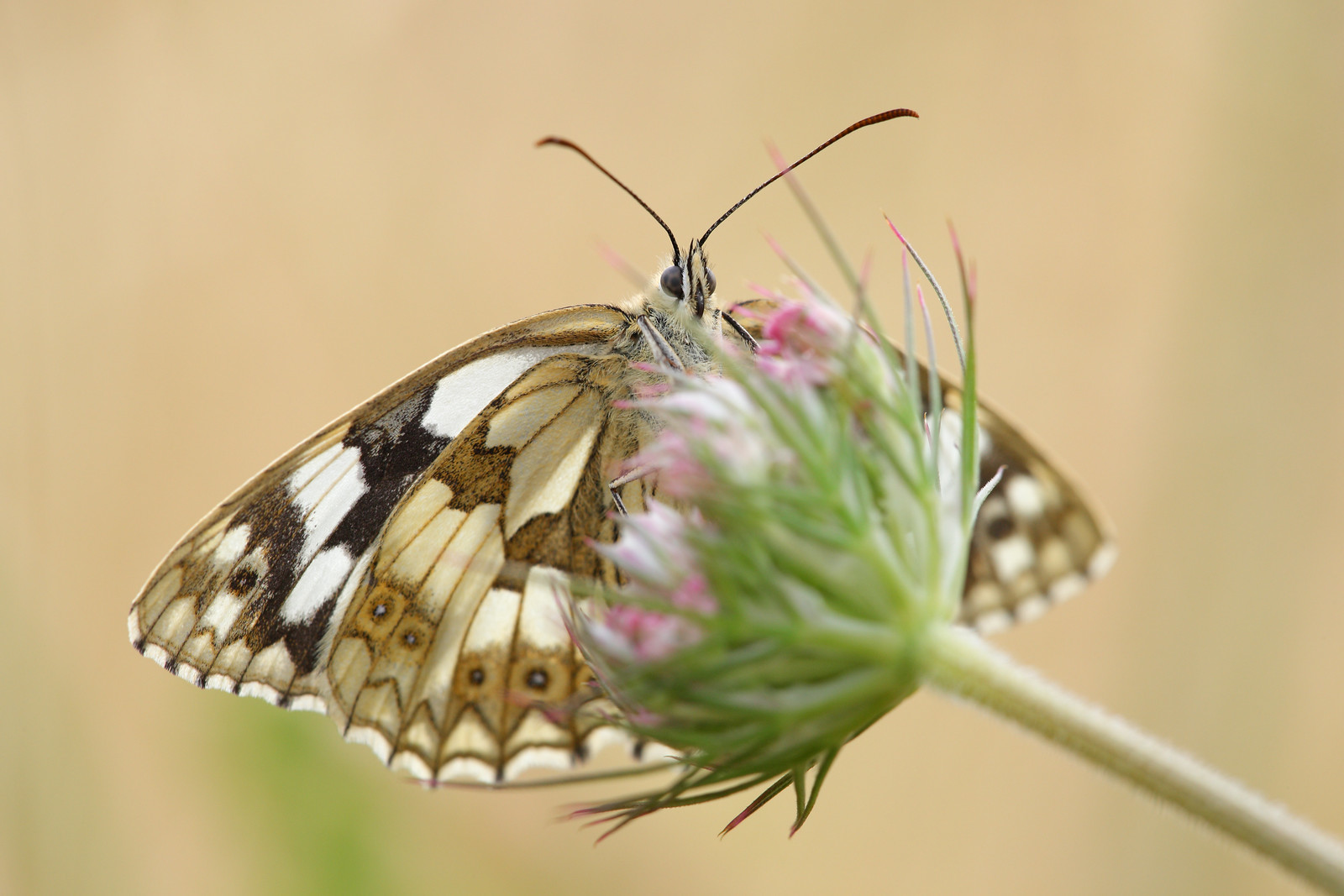
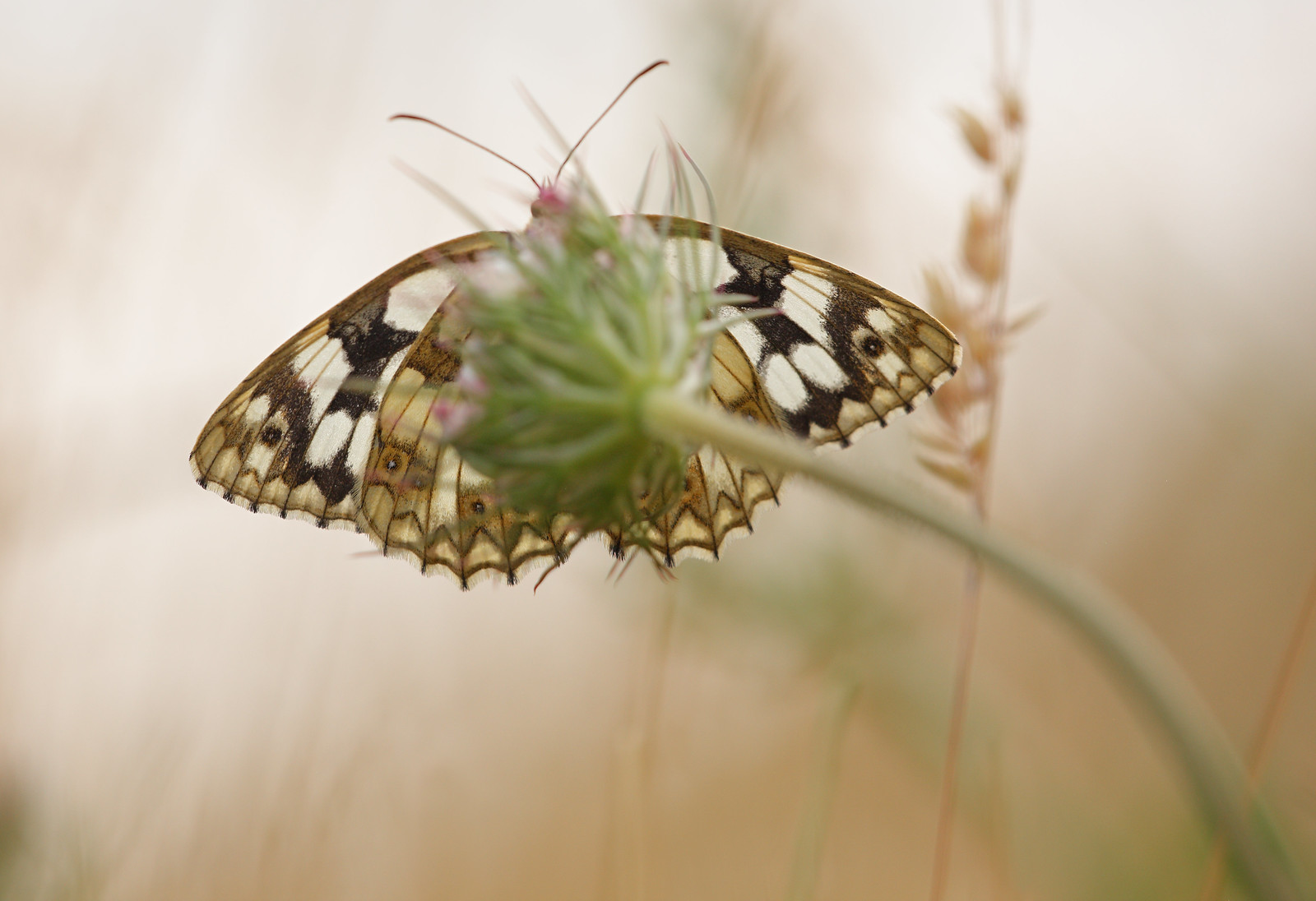
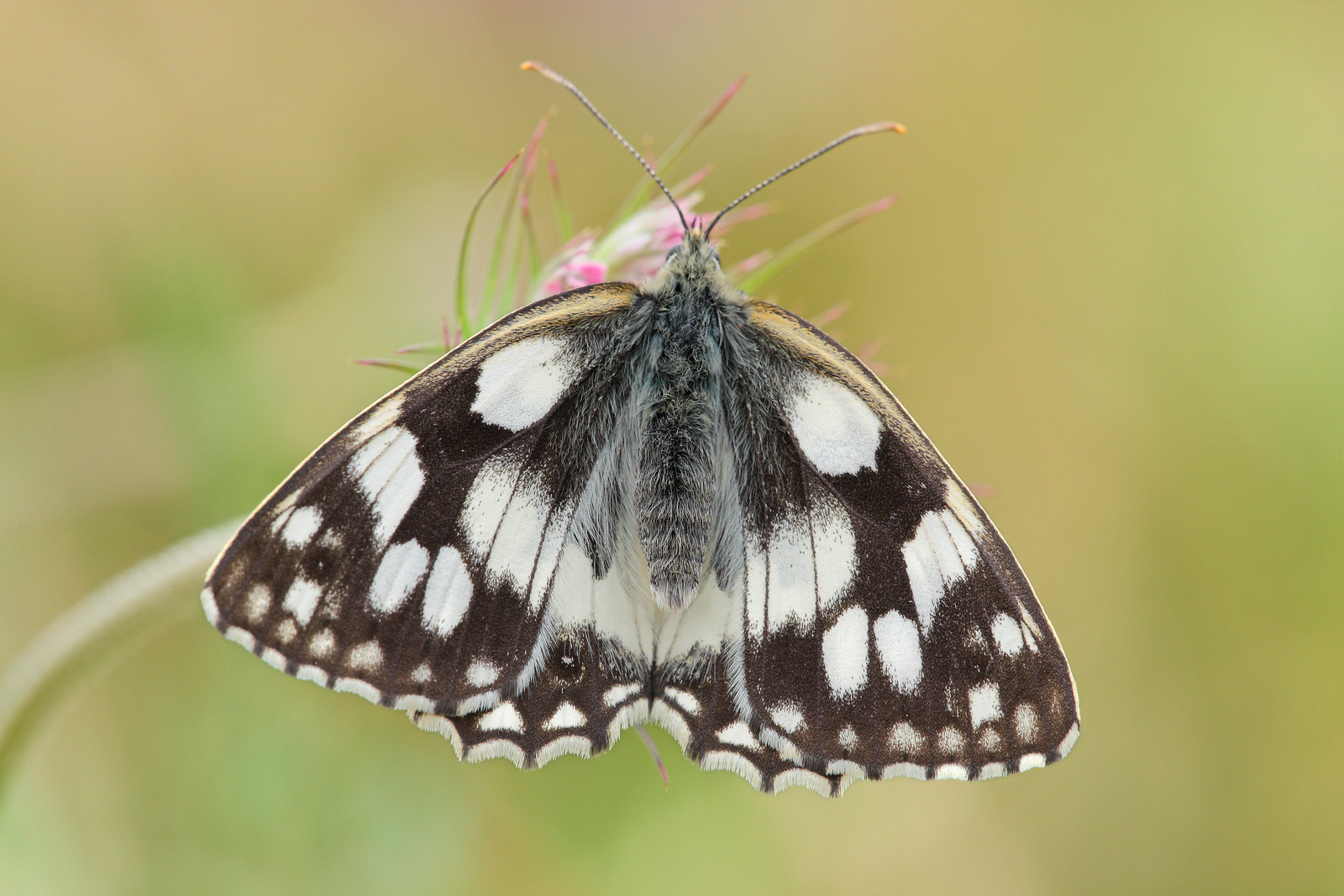
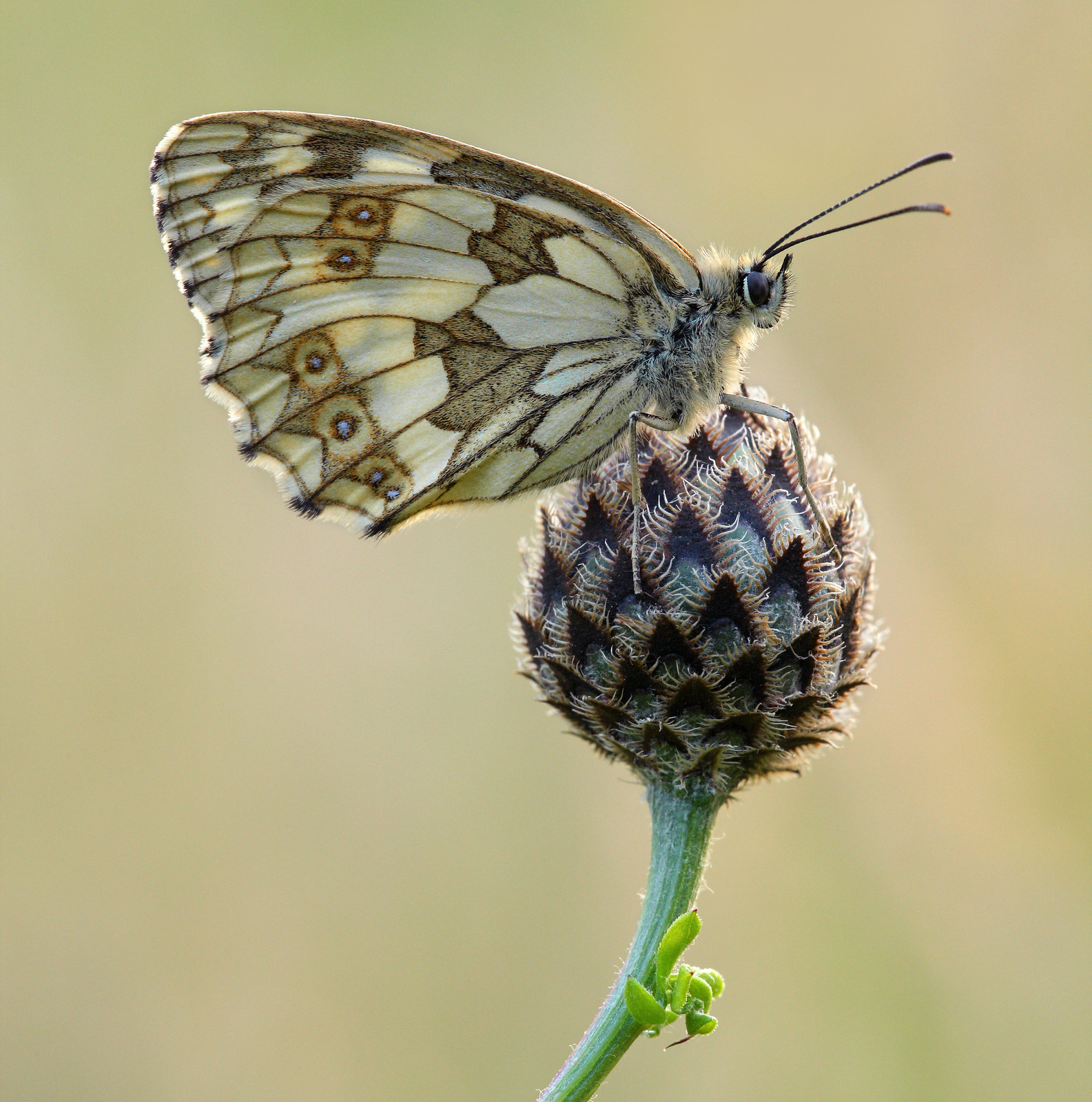
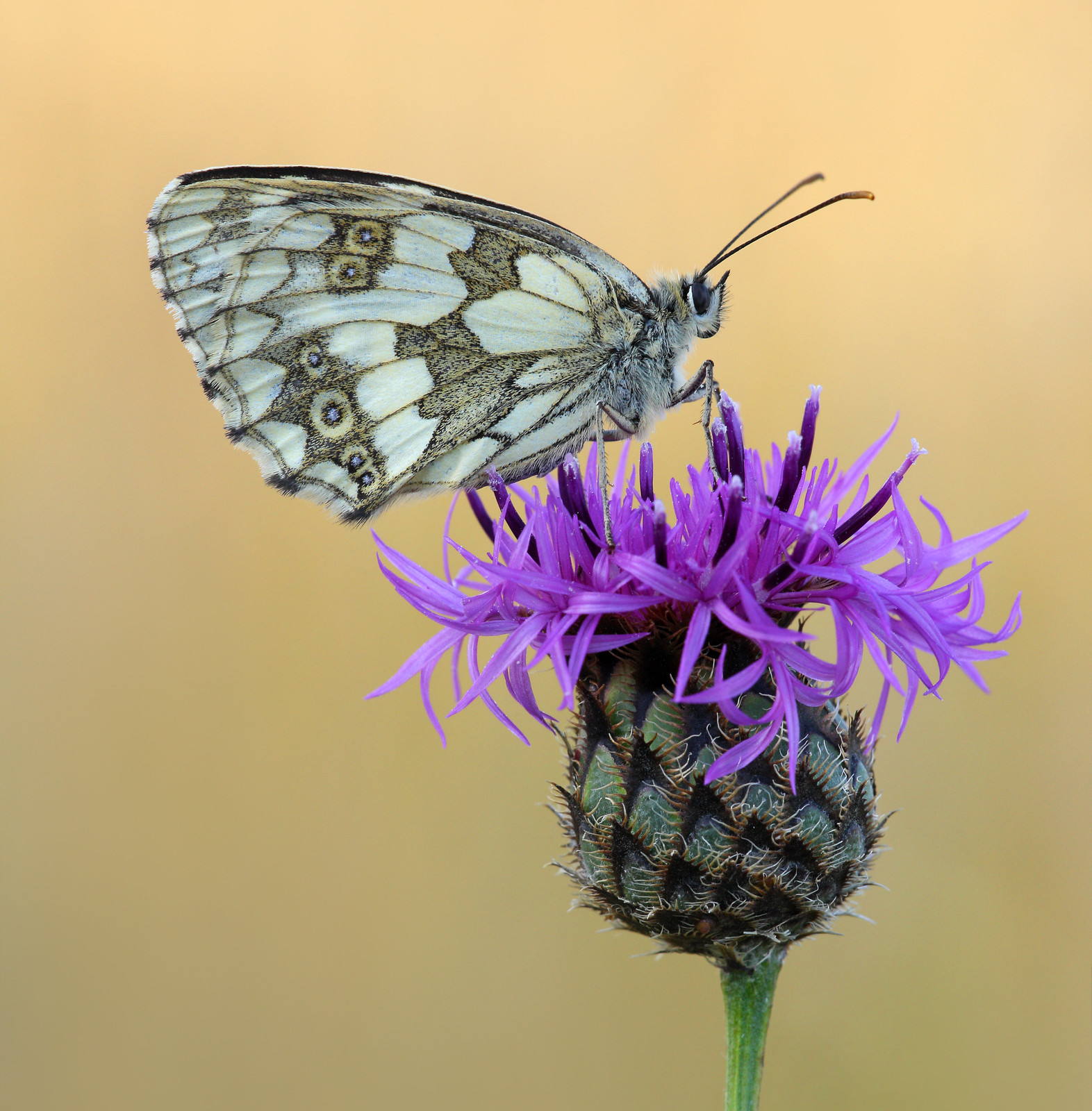
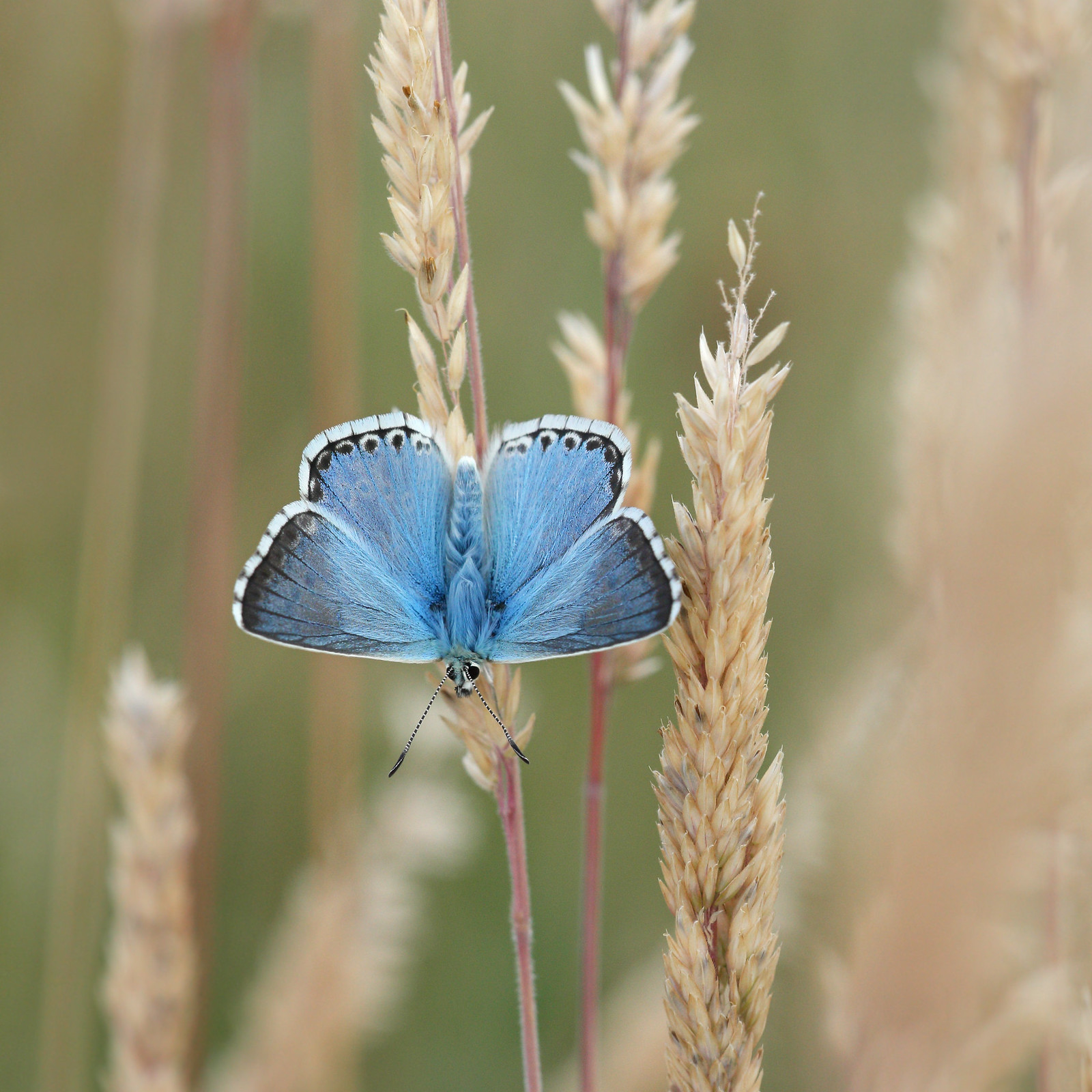
This is a newly emerged Chalk Hill Blue. While cool temperatures immobilise butterflies, so can the heat. With temperatures of 30°C, the butterfly began the final stage of its life-cycle by basking in sunshine. I know what time the site loses sunlight and so it's easy to find open-winged butterflies in transitional, softer light. Photographers often talk about the light being important, but most UK butterflies have subdued colours, which in my opinion look much better in either light shade or soft backlighting.
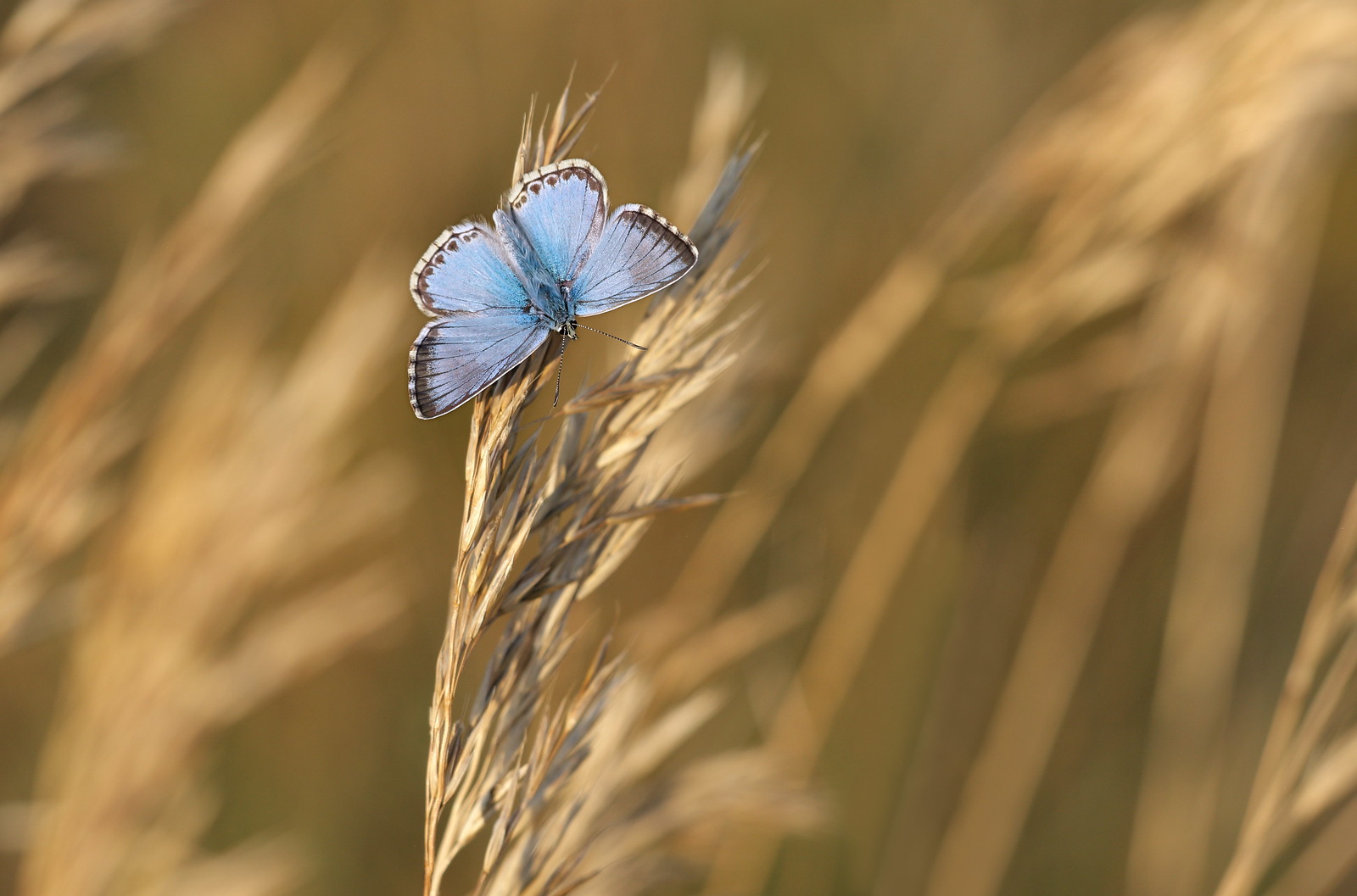
There were plenty of Chalk Hill Blues around on 13th July, but their wings had begun shedding scales, causing the colour to fade. This was one of the few butterflies in the colony to be in visibly good condition. Most others either had their wings closed or looked worn. Most butterflies are just not "built to last" and it's a miracle that they last more than a week. In contrast, the adult Red Admiral can live up to 9 months or longer if there's a mild winter. One only needs to hear the sound it makes when flying overhead, to understand that its wings and body are far more robust than the Chalk Hill Blue or Marbled White. If you've ever held one, they look ready to disintegrate at the first gust of wind.
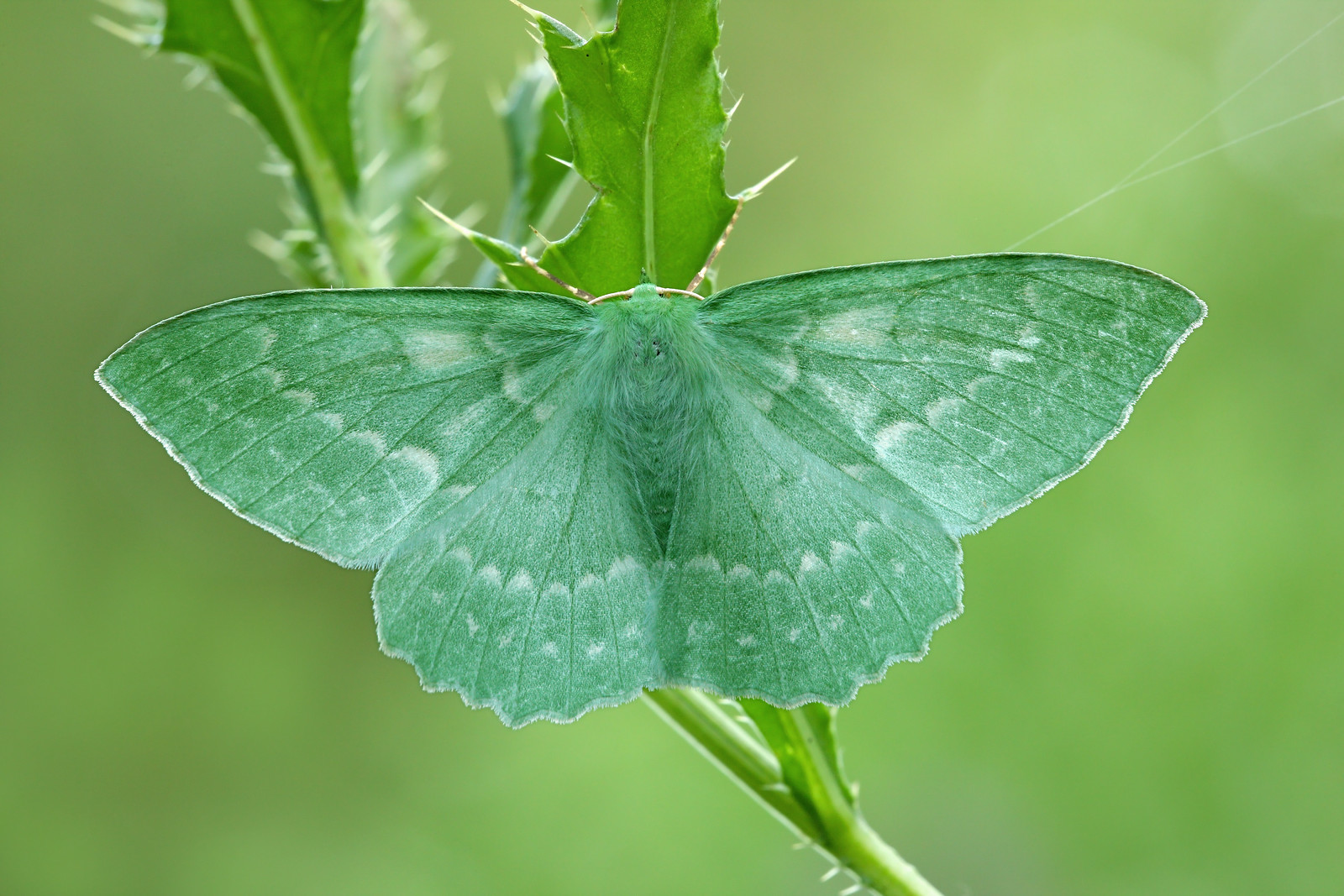

There were plenty of Chalk Hill Blues around on 13th July, but their wings had begun shedding scales, causing the colour to fade. This was one of the few butterflies in the colony to be in visibly good condition. Most others either had their wings closed or looked worn. Most butterflies are just not "built to last" and it's a miracle that they last more than a week. In contrast, the adult Red Admiral can live up to 9 months or longer if there's a mild winter. One only needs to hear the sound it makes when flying overhead, to understand that its wings and body are far more robust than the Chalk Hill Blue or Marbled White. If you've ever held one, they look ready to disintegrate at the first gust of wind.

I was searching for roosting butterflies, when I spotted this night-flying Large Emerald moth adjacent to some young birch trees. The caterpillar starts as brown, but turns green after overwintering and feeds on Honeysuckle and birch, which is in abundant supply in the woods. The moth is attracted to light sources. There is no definitive explanation for this phenomenon, but one theory is that they use celestial objects, such as the moon for navigation. Night-flying moths could also reference the moonlight when they come to roost for the day.
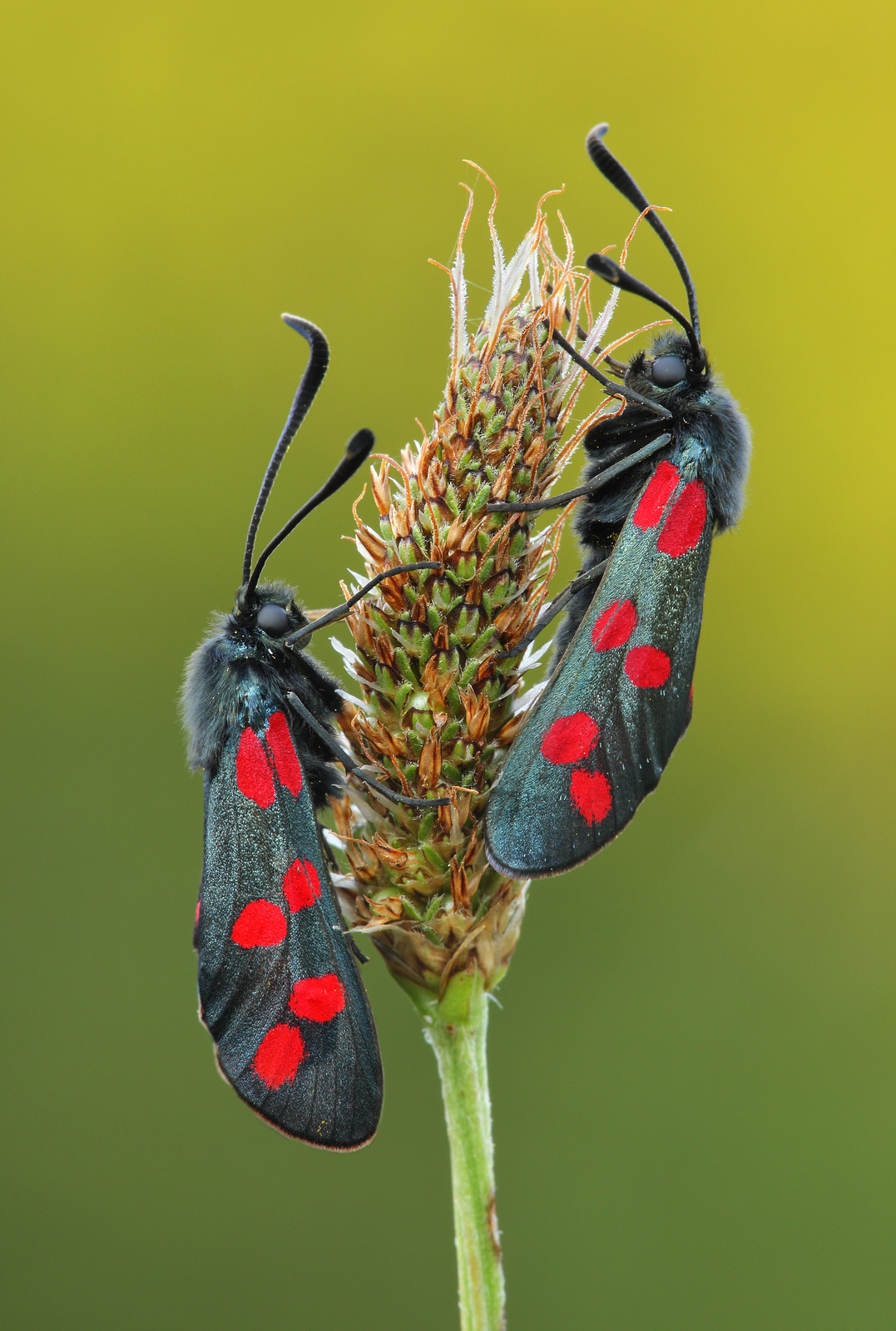
This image of two Six-spot Burnet moths shows how choosing subjects with a great background can dramatically improve a macro shot. The yellow-green gradient is the treeline partly bathed in evening sunshine at a distance of 65 metres. I avoid backgrounds that are too light, as either the subject will be underexposed or the background blown out. I dislike unnaturally dark or black backgrounds, because they can rob the image of vital context.
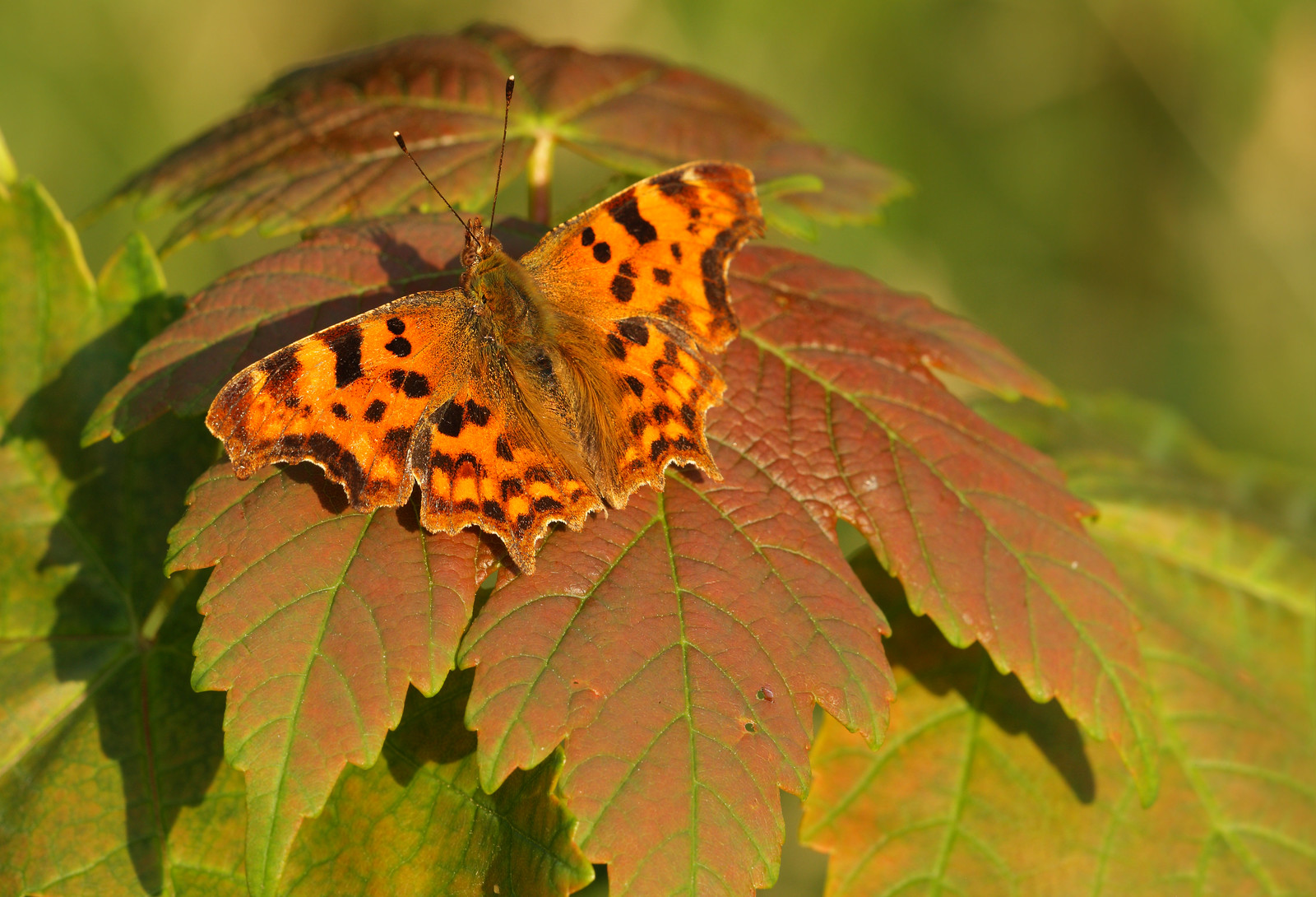
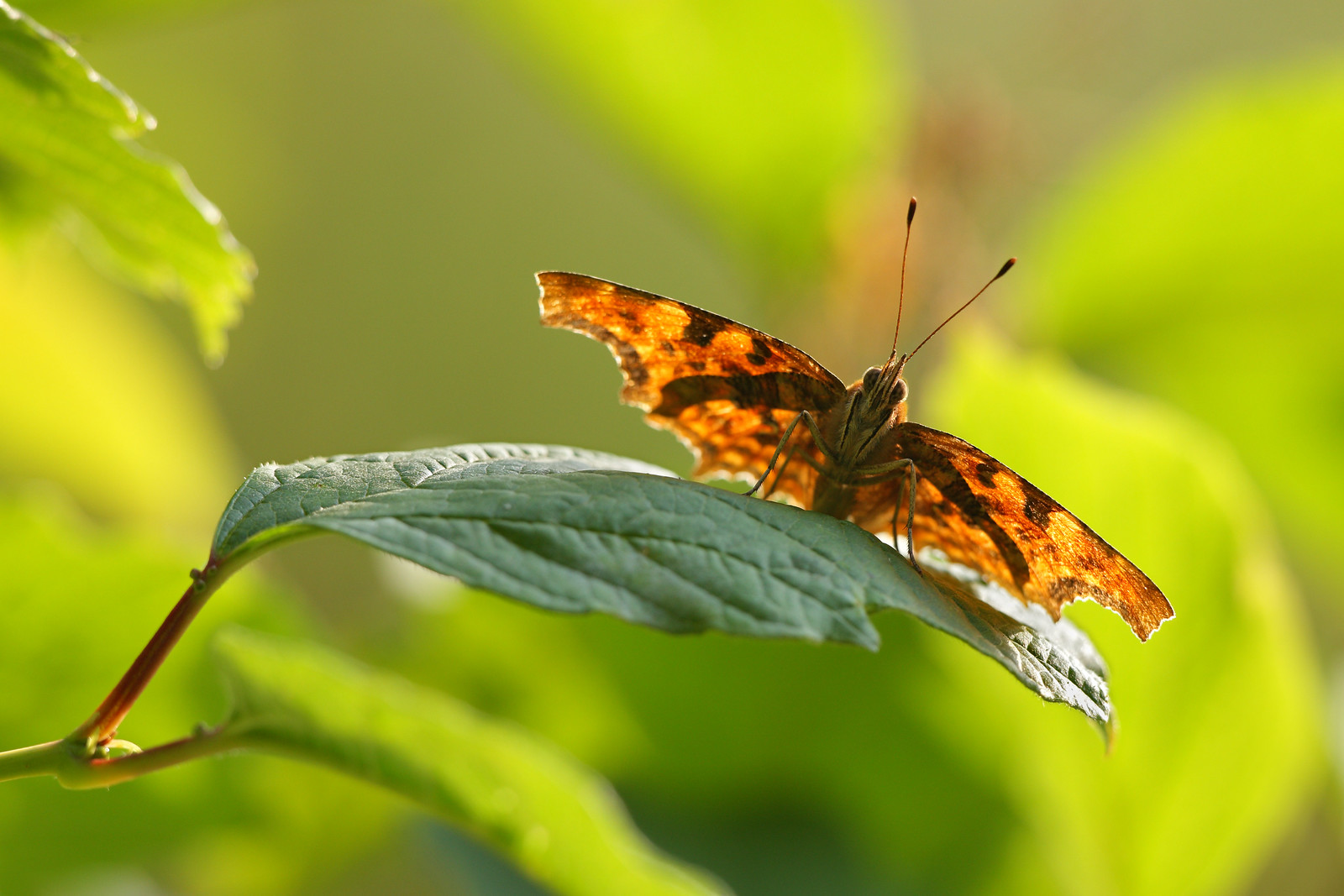
The Comma experienced a serious decline in the 20th century, followed by a sharp recovery. During winter hibernation, its scalloped wings and dark colouring when closed offers camouflage amongst dead leaves. The butterfly gets its name from a light marking on the ventral side of its wings.

You would be forgiven for thinking this wild flower meadow was straight out of Carol Klein's Devon garden, but I found this eclectic mix of flowers growing in a nature reserve on the South Downs. The flowers and plants support a variety of insects, including butterflies and in turn birds. It's a fine and sadly rare example of wild meadow which was once commonplace in the UK, but due to intensive farming and climate change, is now in critical danger.
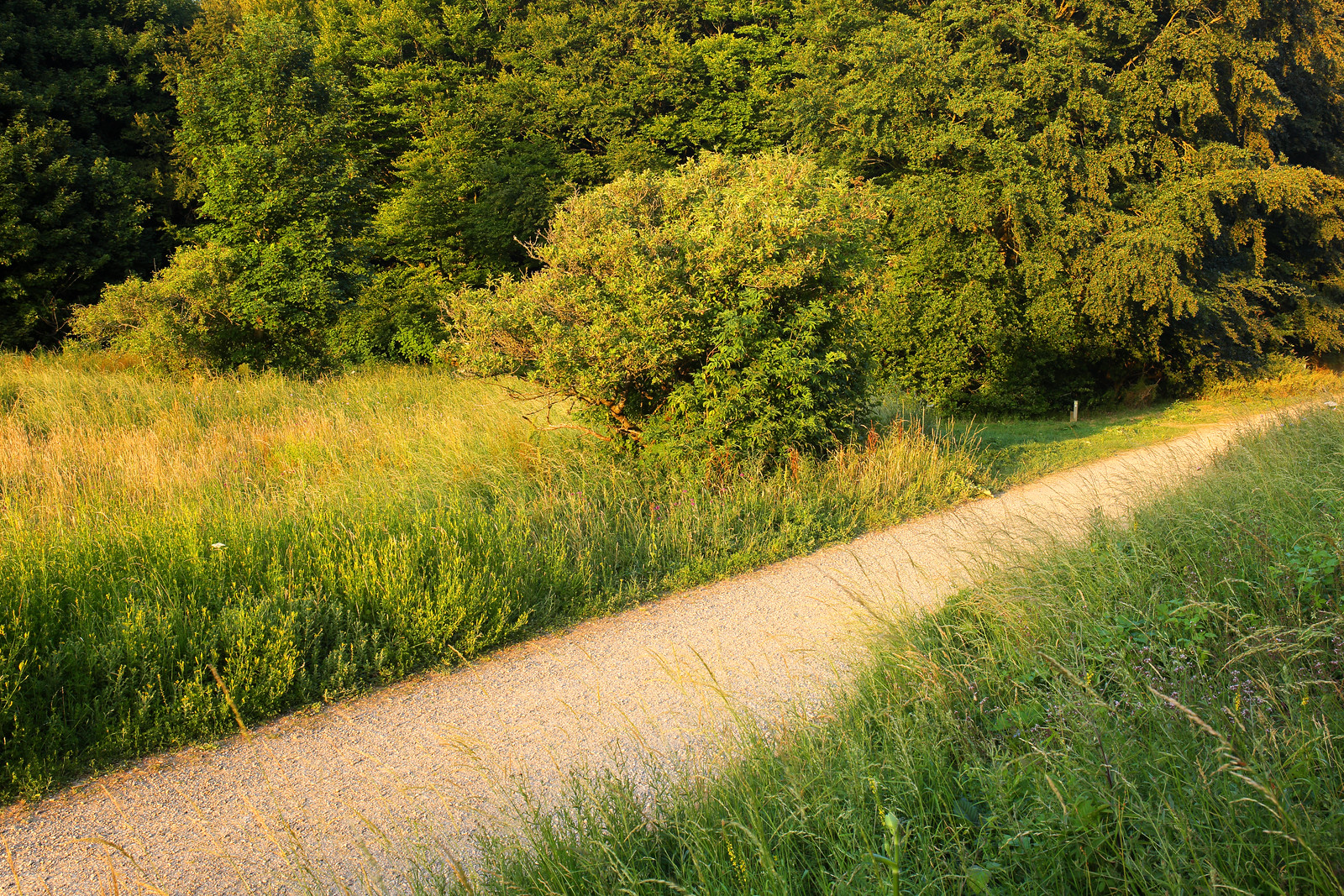
One of my butterfly sites is a meadow, buried deep inside a forest. Set in a valley, tree cover provides shelter from winds in most directions. Comma butterflies can be seen along the paths, as they bask in sunshine, before taking off at regular intervals to energetically fight off other Commas competing for territory. I spent 75 minutes working along a 30 metre stretch seen above to get the Comma photo. On one evening, I spotted the languid flight of a White Admiral gliding back and forth. To my frustration, it took flight before I could get close. Although it can be seen in fairly large numbers at some sites, an unknown cause has lead to a sharp decline in numbers over the past 20 years. I saw a couple of Dark Green Fritillaries in another meadow and despite walking around to spot them roosting, I was out of luck. A man from UK Butterflies advised me that 2018 has been a poor year for this species.
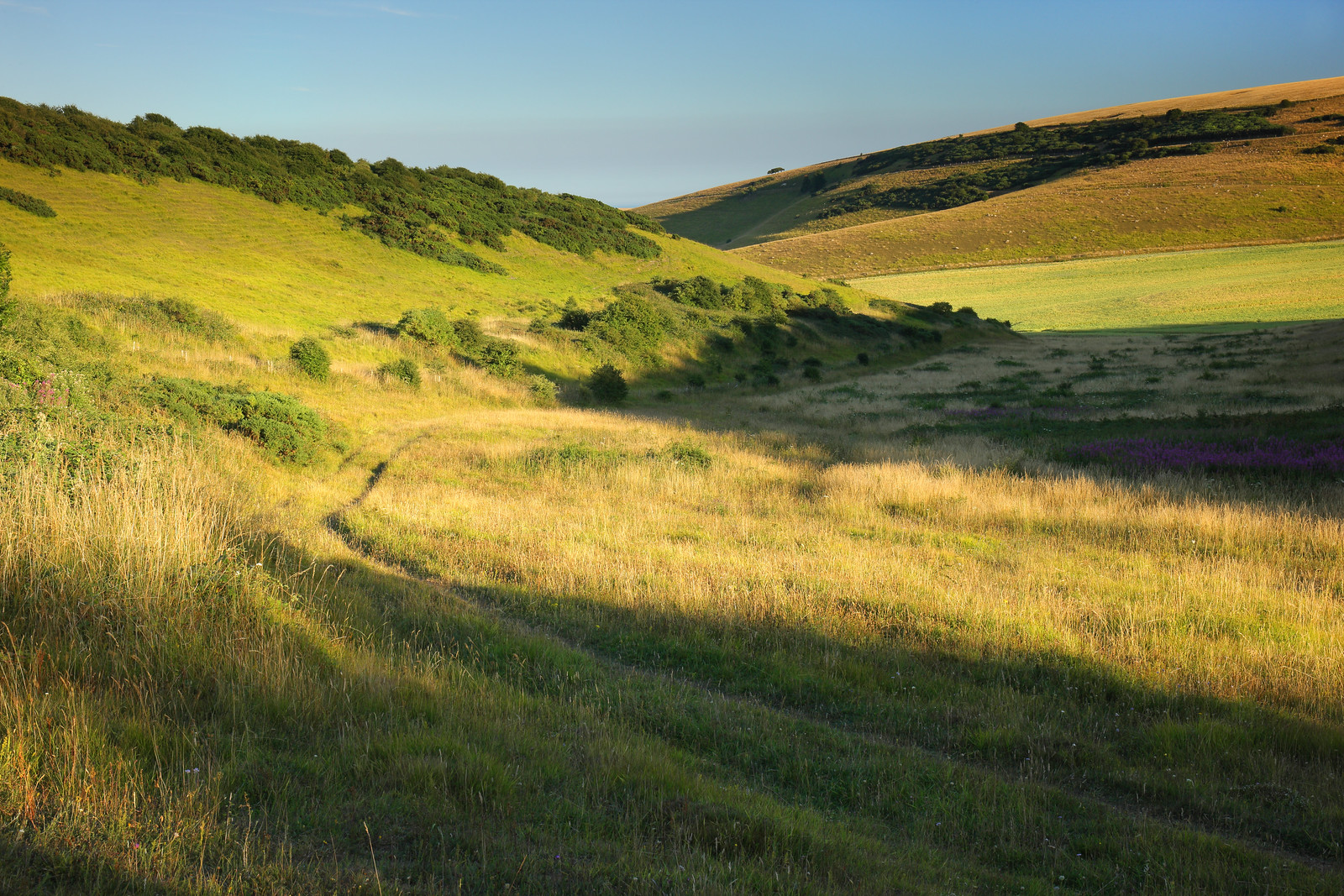
Castle Hill National Nature Reserve is an example of a great butterfly meadow, which is also disappointing as a site for butterfly photography. If you want to spot butterflies for recreation or count numbers, it's the site for you. But if you intend to photograph species like the Peacock, Comma or Red Admiral, which look best in daytime with open wings, be prepared for the butterflies to disappear into the large open space. Smaller, less mobile species might not fly 100 metres up the hill, but the exposed aspect can make it too windy. I have a strong preference for sheltered woodland glades, small meadows surrounded by woodland and hillside meadows protected from prevailing winds by forests. Confined spaces mean territorial species will return to the same spot to feed or bask, even if disturbed. If the site is protected from the wind, images will be sharper. It's inevitable that even the most careful photographer will create disturbance, but if you choose locations carefully, the butterflies will return and you'll get dozens of chances to get that quality image. The woodland meadow in the previous image is home to only about 10 butterflies, but I've taken some great photos here since discovering the site.
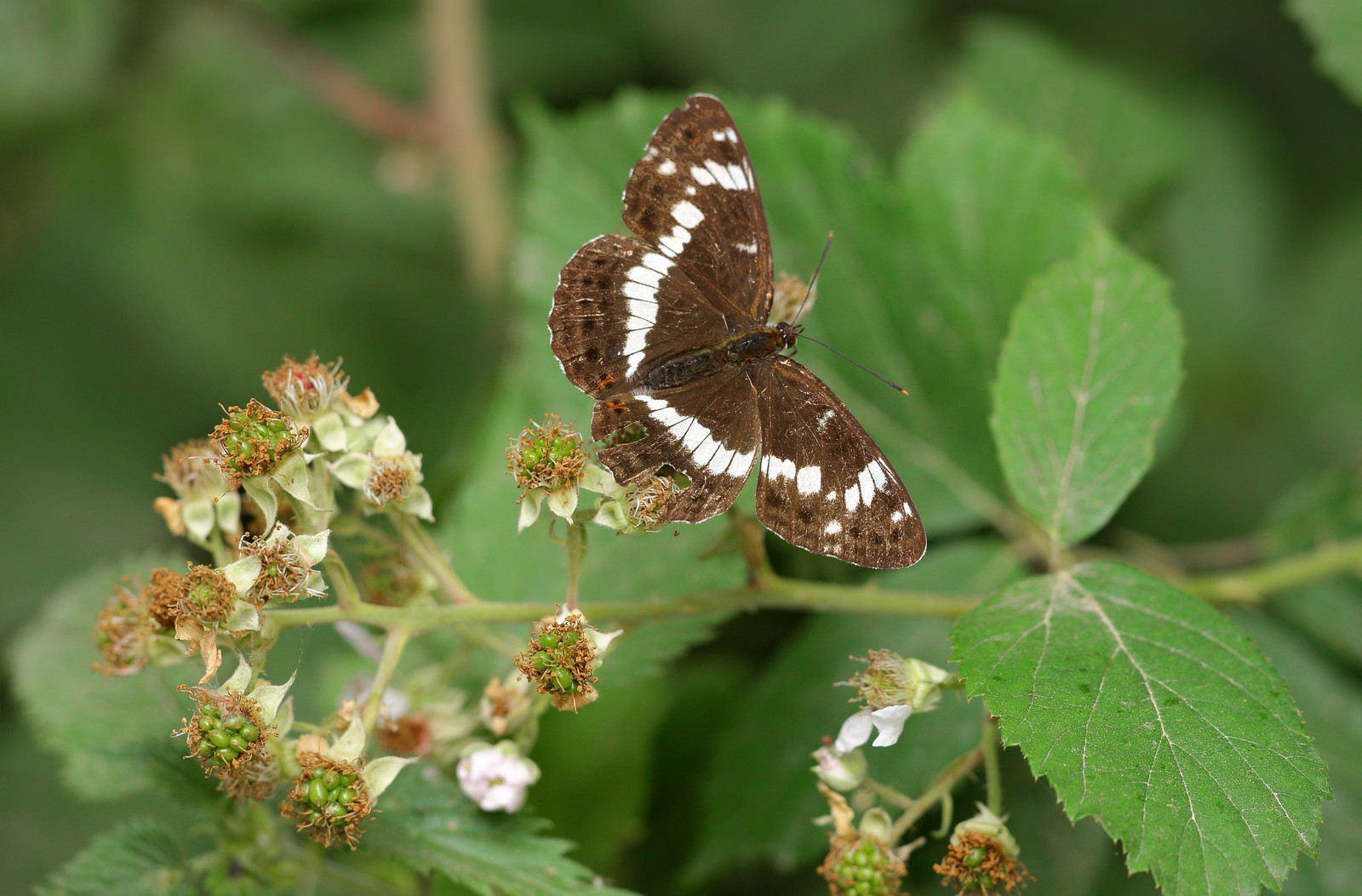
I was about to tuck into my sandwiches, when I spotted two White Admirals gliding through the air above brambles. Their flight behaviour is unmistakably languid and almost reminds me of autumn leaves floating down from the tree canopy. A mother and daughter riding on a pony and cart pulled up behind a gate and saw what I was doing. To my relief, they waited until the butterfly flew back into the treetops and I thanked them for being so considerate. If only more people were so thoughtful. Horse riders and cyclists tend to be the most considerate. Close to urban areas, people just walk straight in front of my camera without a second thought. And don't get me started on daft dogs jumping into my set-up!
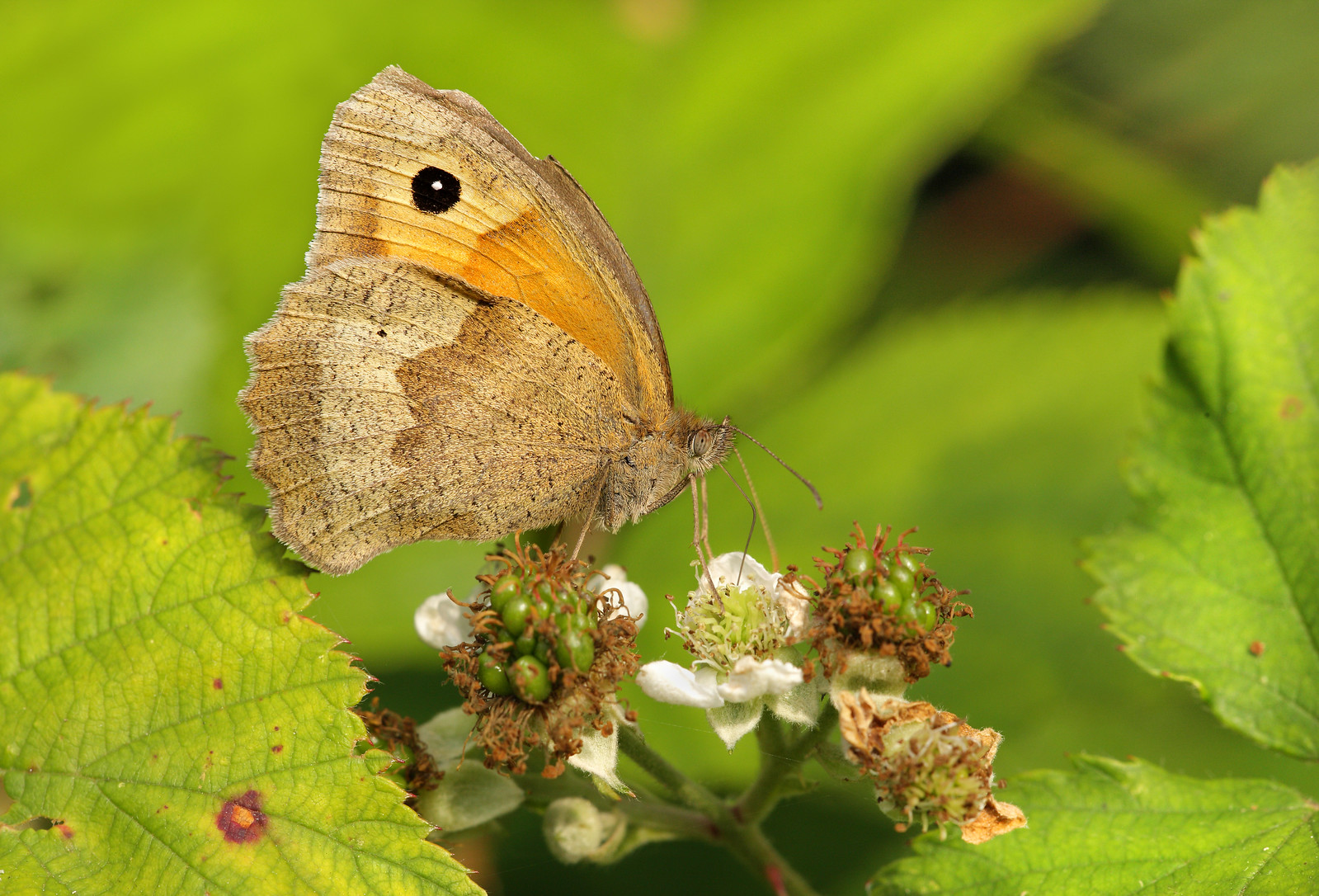
Meadow Browns are prepared to take risks when food plants are available. I knelt down in a field, with the blazing sun on my back, as dozens of Meadow Browns fed just 20 cm or less from me. The sun disappeared behind clouds early, so I took a stroll. The Meadow Browns reverted to type and wouldn't let me anywhere near them. Suddenly, a rare migrant butterfly took off from the brambles and soared into the trees. I had seen it in the Booth Museum with a pin through its back, but immediately knew it wasn't a British species. I identified the butterfly as a Camberwell Beauty, a non-resident migrant from Scandinavia, which was probably aided by hot weather and easterly winds in its migration across the North Sea. It's amazing that such small creatures can fly long distances, but at altitudes of 1km or more, strong air currents can drastically cut the journey time. I doubt the butterfly took a direct route straight from Scandinavia; it probably had stop-overs and crossed from the Netherlands or Belgium. It has a large wingspan, a cream border and an iridescent purple/burgundy top-wing. People from Scandinavian and North American countries would probably just laugh and tell me that the Camberwell Beauty is a common sight in their neck of the woods.
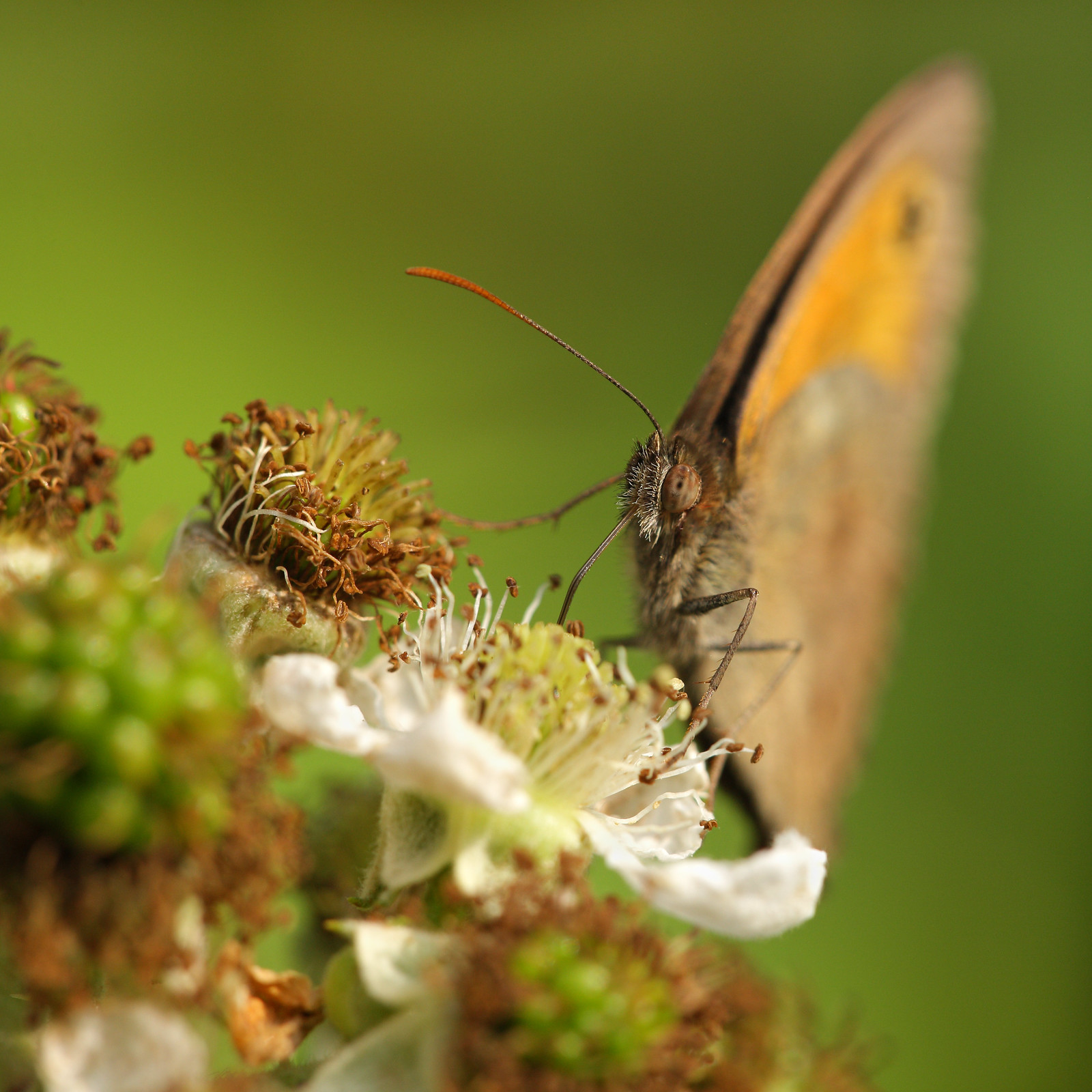
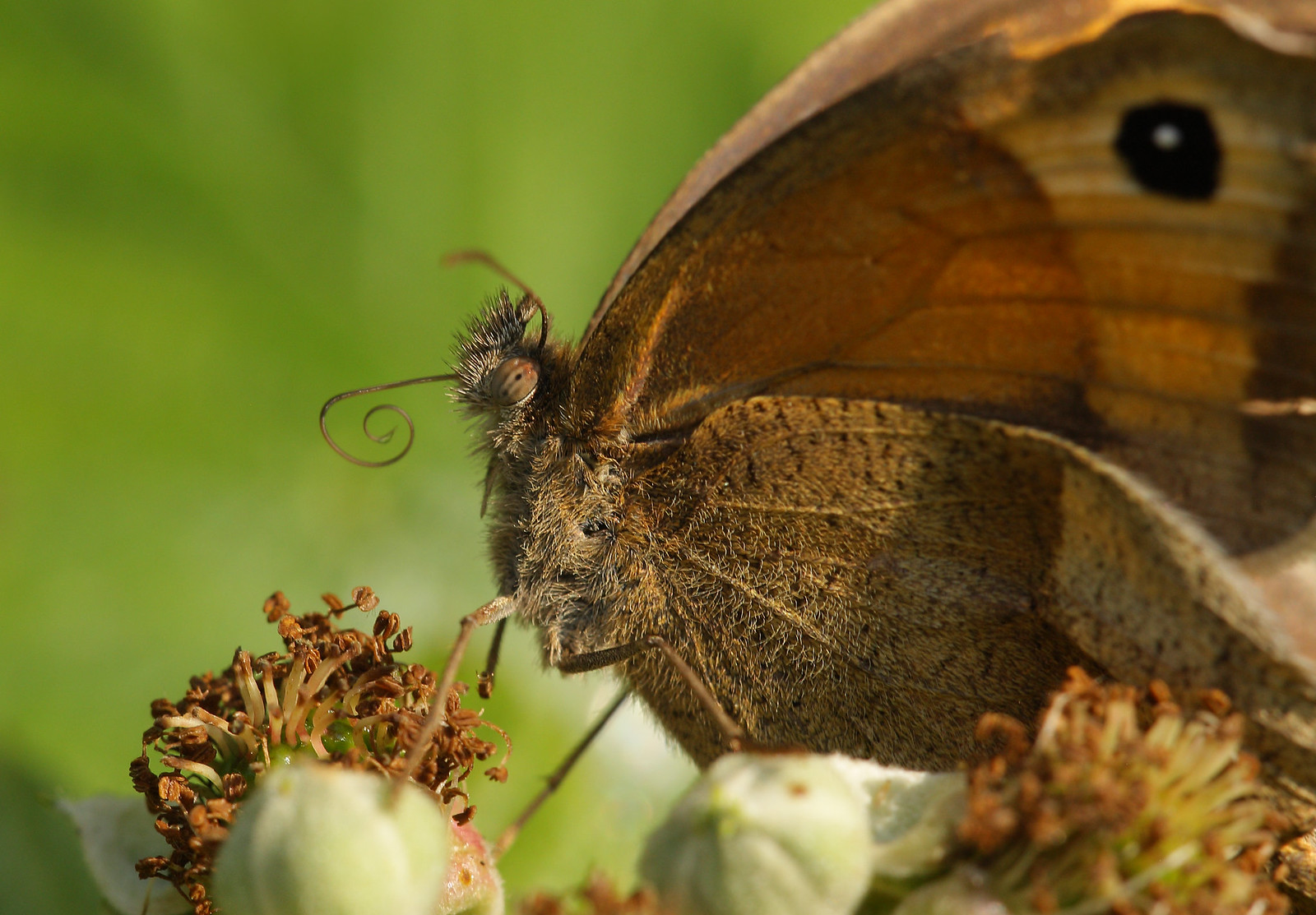
Butterfly vision enables the insects to see higher frequency ultraviolet light, but lower frequency red is invisible to them. Compound eyes afford them omni-directional vision, but they are unable to focus light and therefore everything is a blur. Nevertheless, this is sufficient to make out landscape features, identify food sources and each other and evade predators.
The Meadow Brown has a low status among many butterfly aficionados. The common brown is a highly successful species, due to its ability to feed on a variety of plants, the anti-predator adaptation of its wing eyespot and the said tendency to fly off when it detects barely audible movements. Meadow Browns and Purple Emperors are unequal in status, but the former is far more important to the ecosystem as a pollinator and contributor to the food chain.


The Comma experienced a serious decline in the 20th century, followed by a sharp recovery. During winter hibernation, its scalloped wings and dark colouring when closed offers camouflage amongst dead leaves. The butterfly gets its name from a light marking on the ventral side of its wings.

You would be forgiven for thinking this wild flower meadow was straight out of Carol Klein's Devon garden, but I found this eclectic mix of flowers growing in a nature reserve on the South Downs. The flowers and plants support a variety of insects, including butterflies and in turn birds. It's a fine and sadly rare example of wild meadow which was once commonplace in the UK, but due to intensive farming and climate change, is now in critical danger.

One of my butterfly sites is a meadow, buried deep inside a forest. Set in a valley, tree cover provides shelter from winds in most directions. Comma butterflies can be seen along the paths, as they bask in sunshine, before taking off at regular intervals to energetically fight off other Commas competing for territory. I spent 75 minutes working along a 30 metre stretch seen above to get the Comma photo. On one evening, I spotted the languid flight of a White Admiral gliding back and forth. To my frustration, it took flight before I could get close. Although it can be seen in fairly large numbers at some sites, an unknown cause has lead to a sharp decline in numbers over the past 20 years. I saw a couple of Dark Green Fritillaries in another meadow and despite walking around to spot them roosting, I was out of luck. A man from UK Butterflies advised me that 2018 has been a poor year for this species.

Castle Hill National Nature Reserve is an example of a great butterfly meadow, which is also disappointing as a site for butterfly photography. If you want to spot butterflies for recreation or count numbers, it's the site for you. But if you intend to photograph species like the Peacock, Comma or Red Admiral, which look best in daytime with open wings, be prepared for the butterflies to disappear into the large open space. Smaller, less mobile species might not fly 100 metres up the hill, but the exposed aspect can make it too windy. I have a strong preference for sheltered woodland glades, small meadows surrounded by woodland and hillside meadows protected from prevailing winds by forests. Confined spaces mean territorial species will return to the same spot to feed or bask, even if disturbed. If the site is protected from the wind, images will be sharper. It's inevitable that even the most careful photographer will create disturbance, but if you choose locations carefully, the butterflies will return and you'll get dozens of chances to get that quality image. The woodland meadow in the previous image is home to only about 10 butterflies, but I've taken some great photos here since discovering the site.

I was about to tuck into my sandwiches, when I spotted two White Admirals gliding through the air above brambles. Their flight behaviour is unmistakably languid and almost reminds me of autumn leaves floating down from the tree canopy. A mother and daughter riding on a pony and cart pulled up behind a gate and saw what I was doing. To my relief, they waited until the butterfly flew back into the treetops and I thanked them for being so considerate. If only more people were so thoughtful. Horse riders and cyclists tend to be the most considerate. Close to urban areas, people just walk straight in front of my camera without a second thought. And don't get me started on daft dogs jumping into my set-up!

Meadow Browns are prepared to take risks when food plants are available. I knelt down in a field, with the blazing sun on my back, as dozens of Meadow Browns fed just 20 cm or less from me. The sun disappeared behind clouds early, so I took a stroll. The Meadow Browns reverted to type and wouldn't let me anywhere near them. Suddenly, a rare migrant butterfly took off from the brambles and soared into the trees. I had seen it in the Booth Museum with a pin through its back, but immediately knew it wasn't a British species. I identified the butterfly as a Camberwell Beauty, a non-resident migrant from Scandinavia, which was probably aided by hot weather and easterly winds in its migration across the North Sea. It's amazing that such small creatures can fly long distances, but at altitudes of 1km or more, strong air currents can drastically cut the journey time. I doubt the butterfly took a direct route straight from Scandinavia; it probably had stop-overs and crossed from the Netherlands or Belgium. It has a large wingspan, a cream border and an iridescent purple/burgundy top-wing. People from Scandinavian and North American countries would probably just laugh and tell me that the Camberwell Beauty is a common sight in their neck of the woods.


Butterfly vision enables the insects to see higher frequency ultraviolet light, but lower frequency red is invisible to them. Compound eyes afford them omni-directional vision, but they are unable to focus light and therefore everything is a blur. Nevertheless, this is sufficient to make out landscape features, identify food sources and each other and evade predators.
The Meadow Brown has a low status among many butterfly aficionados. The common brown is a highly successful species, due to its ability to feed on a variety of plants, the anti-predator adaptation of its wing eyespot and the said tendency to fly off when it detects barely audible movements. Meadow Browns and Purple Emperors are unequal in status, but the former is far more important to the ecosystem as a pollinator and contributor to the food chain.
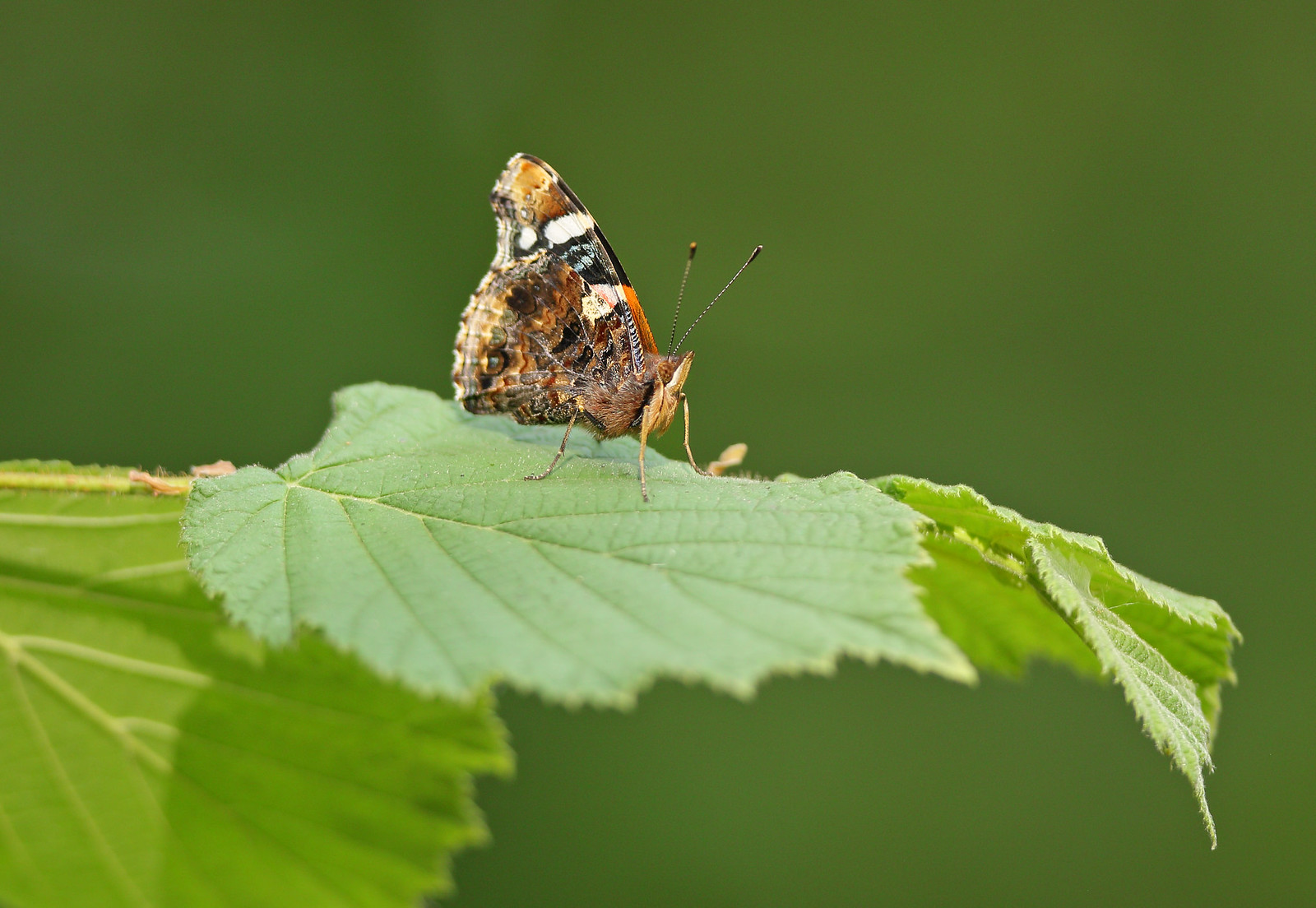
This male Red Admiral spent its time fighting off intrusions from other males by flying in a helical path before returning to its perch. The butterfly landed on my head several times and drank sweat from my forehead. This photo inspired me to order a set of Kenko branded extension tubes, which are basically hollow metal spacers fitted between the camera and lens to reduce the minimum focussing distance. My 300mm lens has a minimum focussing distance of 2.5 metres, but I can now gain greater magnification at 1.2 metres while maintaining sufficient distance to prevent disturbance. I was touched at how polite and considerate other people were during this visit to a woodland, deep in West Sussex. Horses normally panic when they see my telephoto lens and tripod, so I placed it on the ground when a group of young girls came riding along. Each and every one of them said thank you and apologised in case they had disturbed me in any way.
Like so many of my wildlife sites, this one is a good 3 miles from the nearest train station. Some are even further, which is off-putting to a non-car driver carrying 10kg of equipment. Leaving sites early to catch a train means lost opportunities with the camera. Frankly, I've become tired of all the long roadside walks, blisters and getting back really late. Happily, this problem is now resolved, after I purchased an electric bicycle to zip me to and from my sites in 10 minutes. The Bosch motor takes me up steep hills like a magic carpet, fast acceleration gets me through busy junctions safely and the range of 60 miles could see me home if all trains were suddenly cancelled. The bike also brings the possibility of Micheldever and Dockey Wood next spring and opens the door to early morning landscape photography on the South Downs.
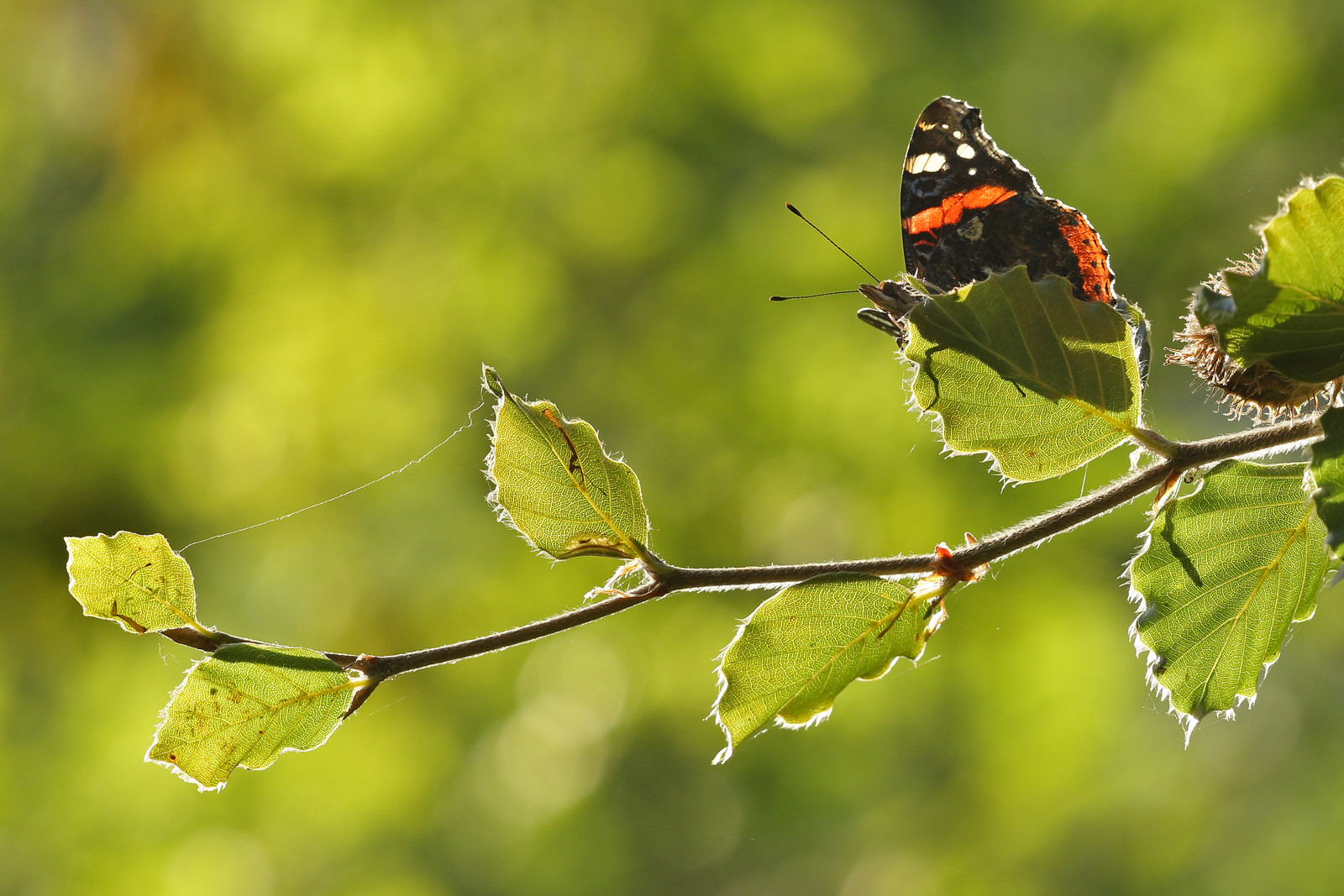
I've been
visiting a site near Brighton on and off since 1999 and one can
always spot males trying to disorientate intruders before returning to
bask in the sunshine. The ability of males to patrol and defend their territory can mean the difference between passing on his genes or losing the evolutionary race, as
females will only mate with males which hold territory. This is where I began learning how to photograph
butterflies. I've come a long way since then, but the nature reserve
will always have a special place in my heart.
Every spring, Red Admirals migrate from southern Europe and North Africa, as food sources die off in hot, dry weather. Female arrivals lay eggs, leading to fresh butterflies from July onwards. A strong flier, this species can manage well against a strong headwind and is capable of navigating using features in the landscape, such as coastlines and even roads. Observers have seen Red Admirals flying across the English Channel at an altitude of just a few metres, but they can fly much higher and it would seem that the butterfly can vary its altitude to take advantage of air currents. Weather service radar has detected Red Admirals as interference flying at altitudes of up to 2000 metres. Although cold blooded, the Red Admiral has a dark body to absorb heat from the sun and generates enough heat energy through wingbeats to sustain high altitude, low temperature flight.
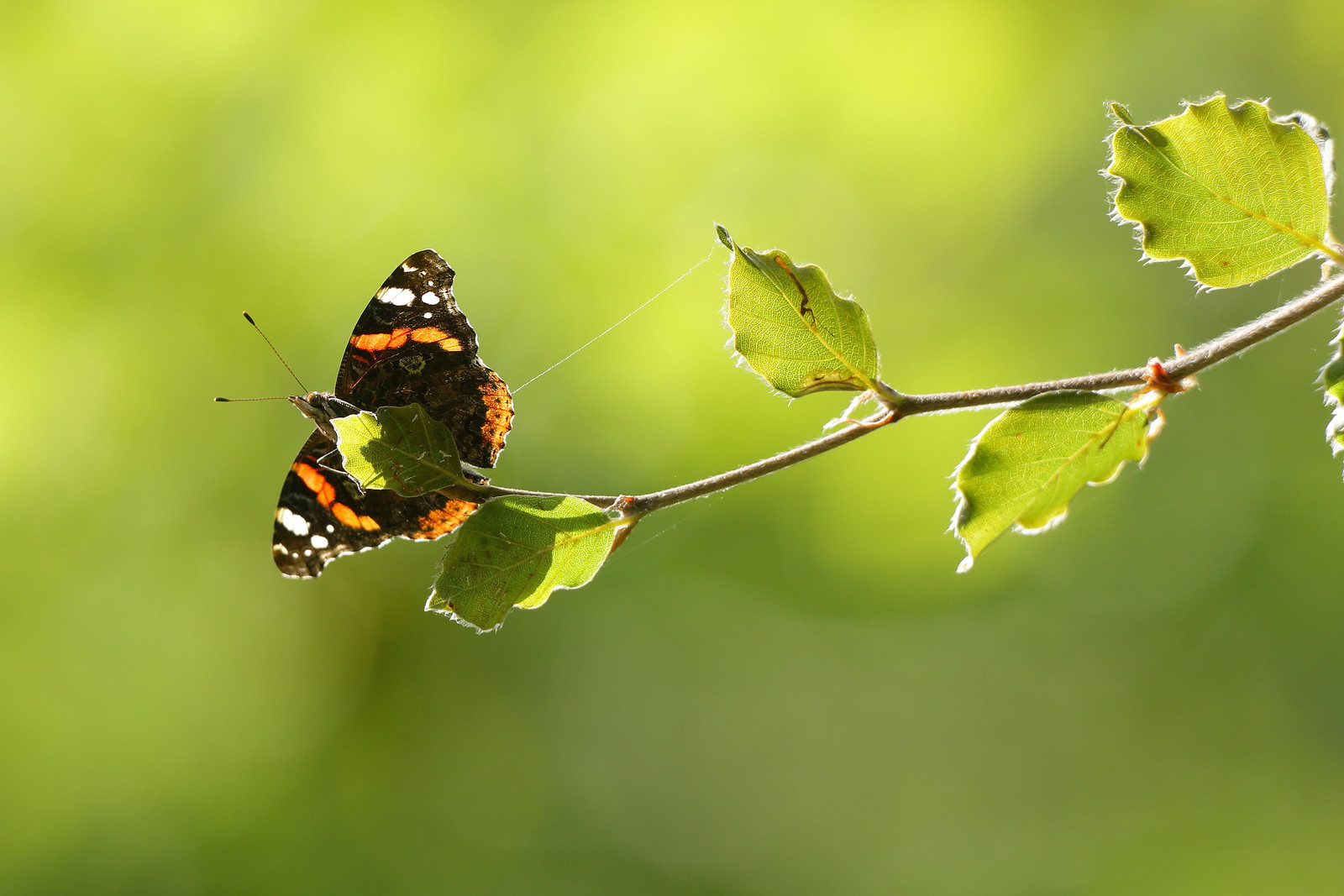
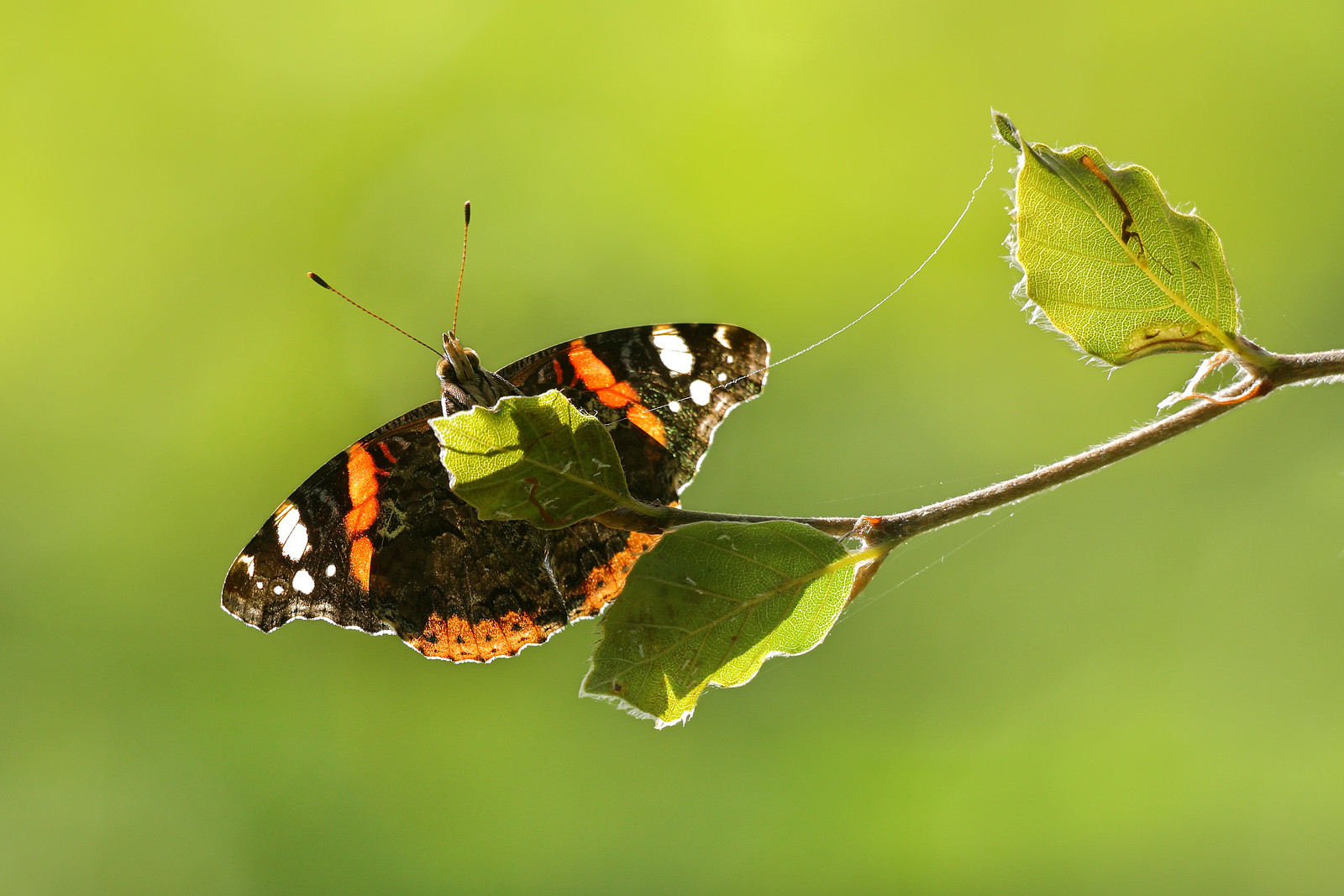
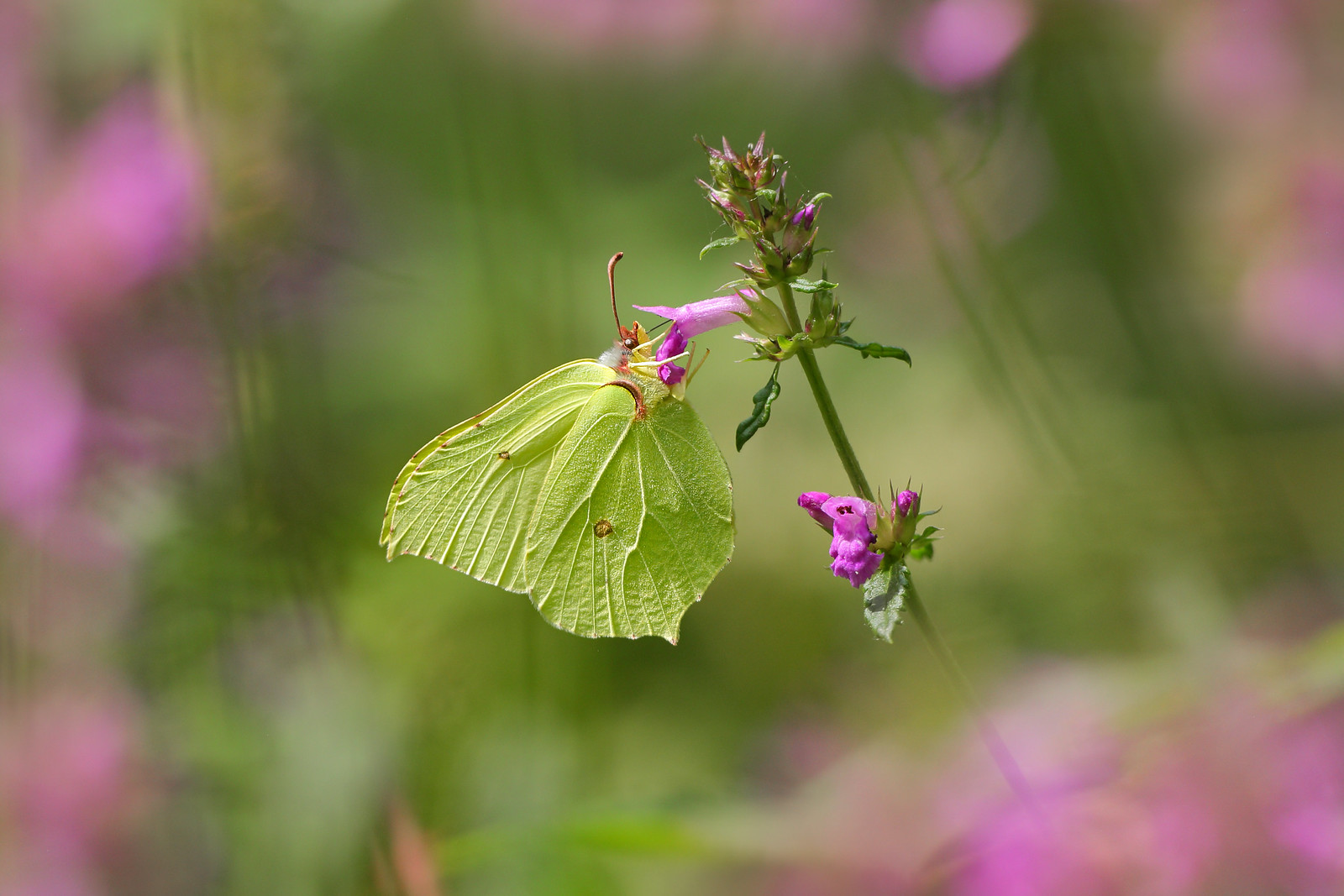
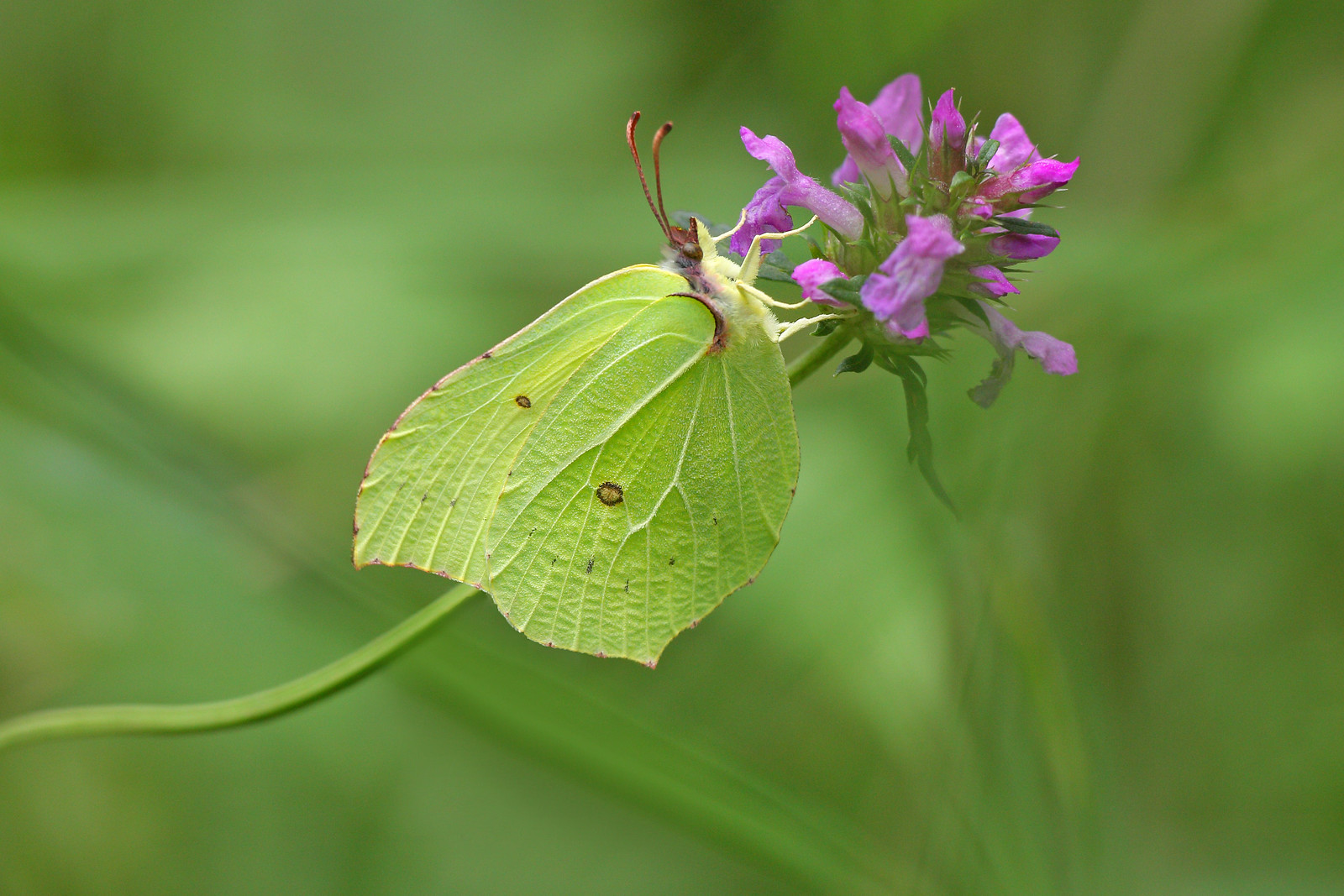
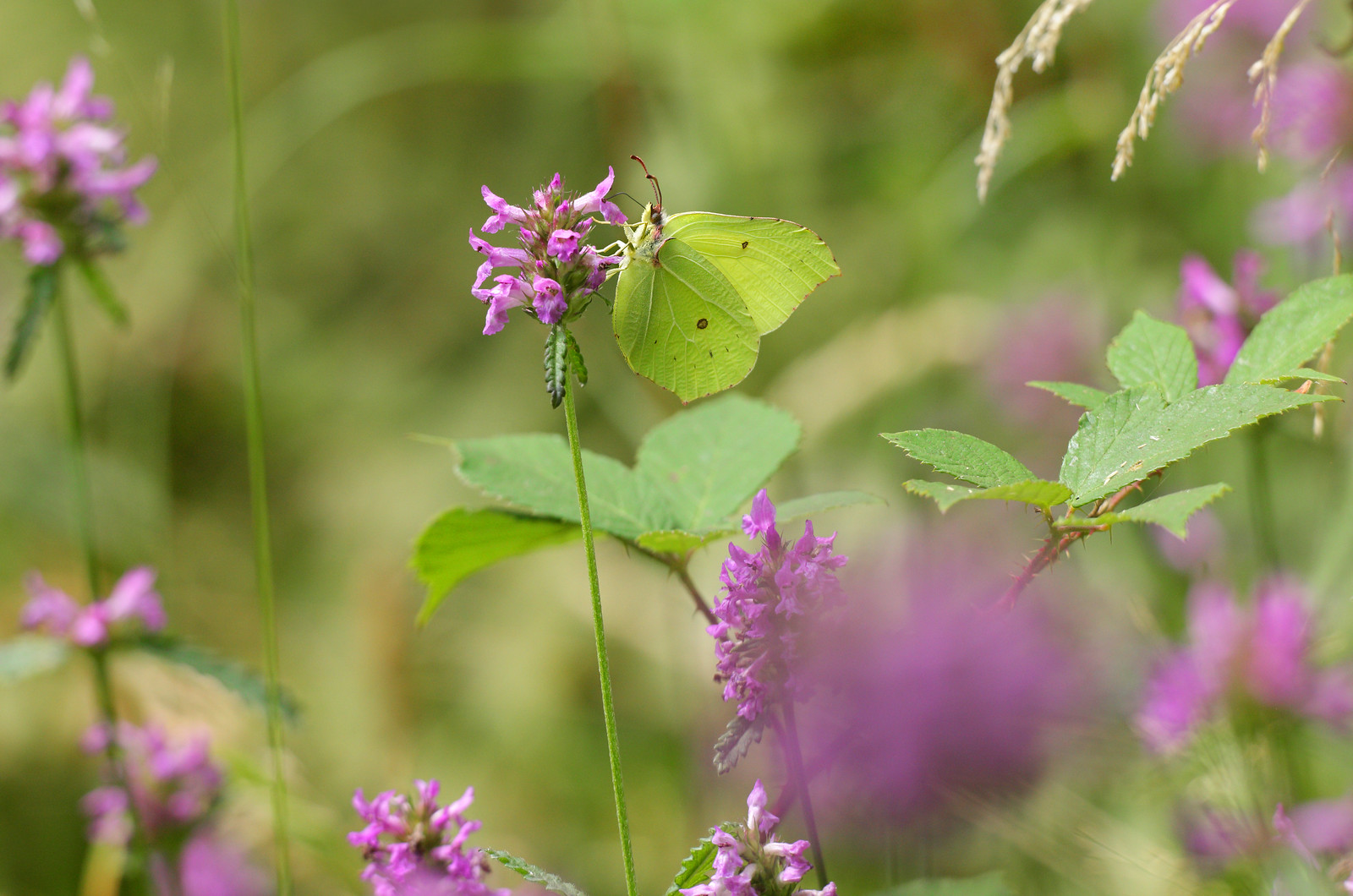
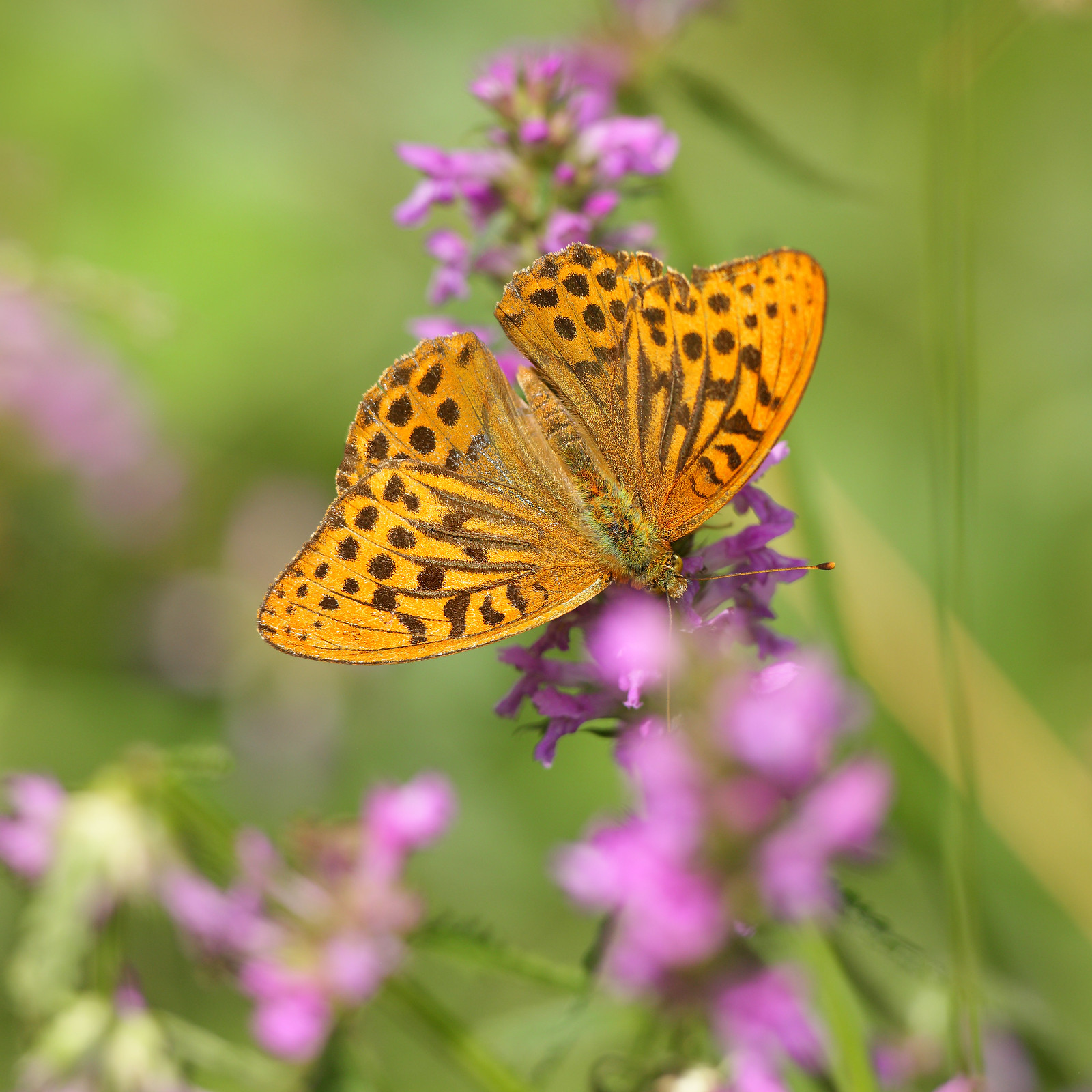
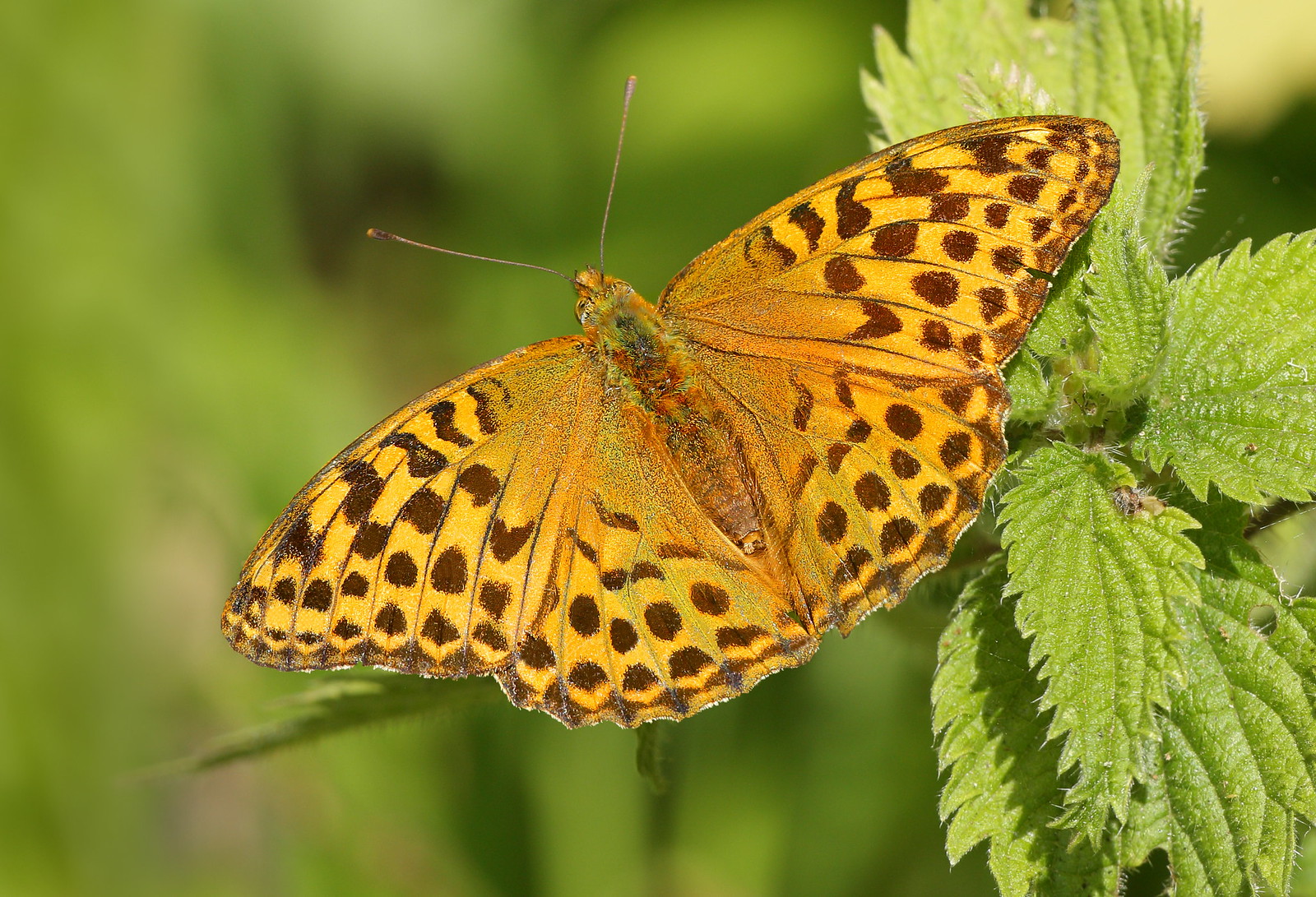
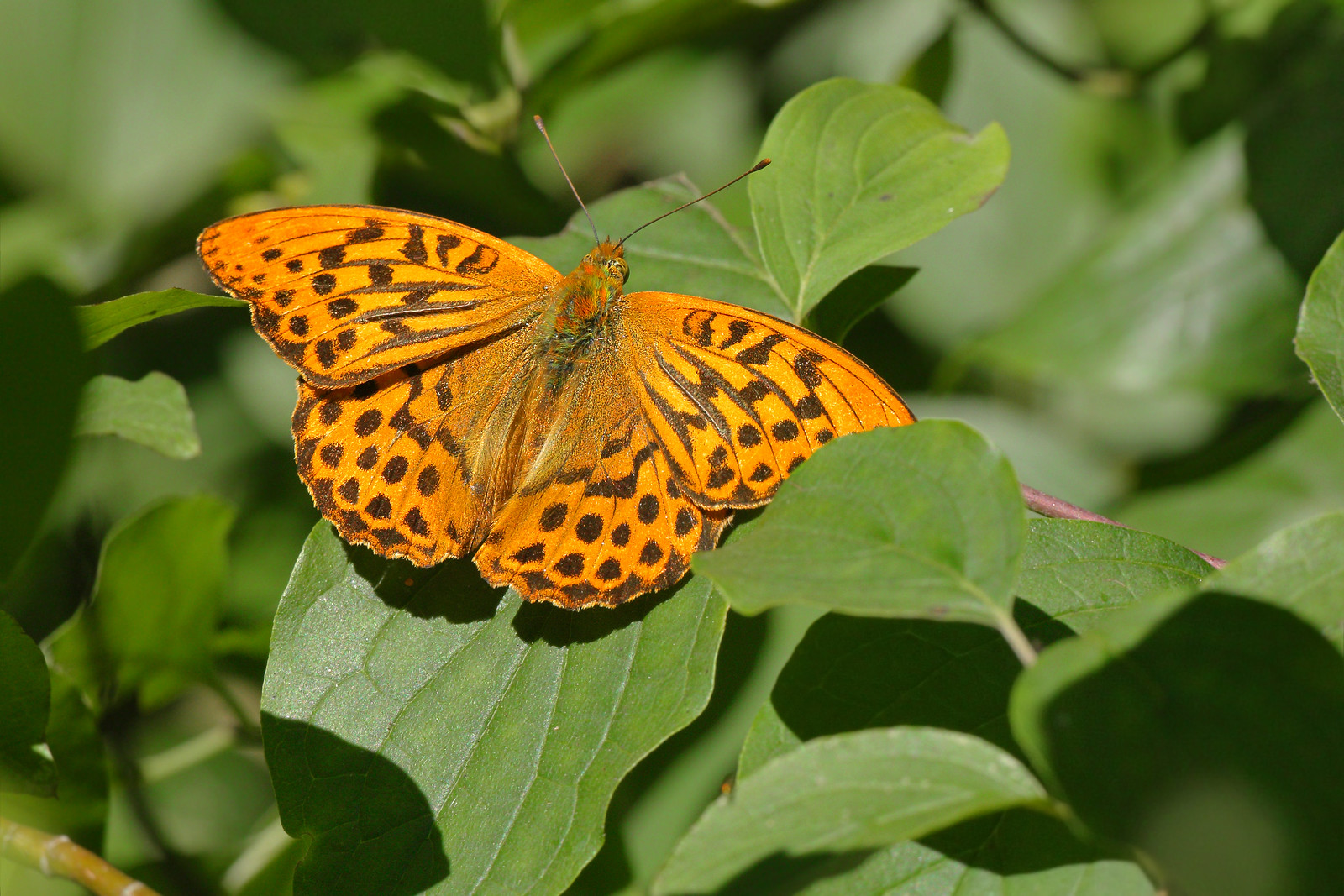
I was delighted to find a reliable site for colonies of Silver Washed Fritillaries and Brimstones in West Sussex. They are seen here feeding on Betony (Betonica officinalis) in a small meadow buried inside a large area of woodland. Four
male Fritillaries chased a sole female around the meadow perimeter for
about 10 minutes, but none succeeded in mating her. It was quite amusing
watching the line of butterflies completing lap after lap in the baking
heat and for some reason, it reminded me of a Benny Hill sketch.
The Brimstone is one of the longer-lived butterflies and I would expect the featured specimens to build up fat reserves by feeding on nectar, before going into hibernation in October and re-emerging in April. The Silver Washed Fritillary only lives for up to 4 weeks and many are eaten by birds before reaching their maximum lifespan. I noticed that its flight behaviour sometimes resembles the White Admiral in the way it glides, rather than beats its wings, from flower to flower. To provide a sense of scale, the upper-left wing belonging to the Fritillary is roughly the same size of a Marbled White.
The
Kenko extension tubes are so useful for such simple accessories and I
wouldn't have taken these images without them. Just spare a thought for
poor muggins getting bitten dozens of times by horseflies in the 31°C heat and that, for obvious reasons, one cannot wear inspect repellent when photographing butterflies!
Comments